Paul van Yperen's Blog, page 151
August 17, 2021
Elio Steiner
Elio Steiner (1905-1965) was an Italian stage and screen actor, who peaked in the early 1930s in films such as La canzone dell'amore (1930), Corte d'Assise (1930) and Pergolesi (1932).
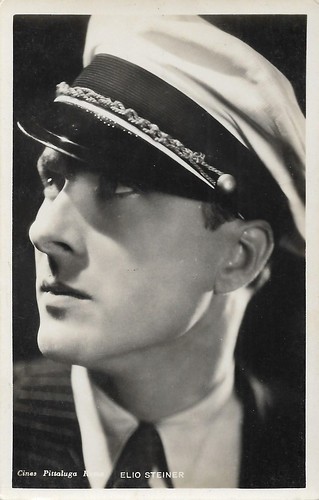
Italian postcard by G.B. Falci, Milano. Photo: Cines Pittaluga / ACIEP.
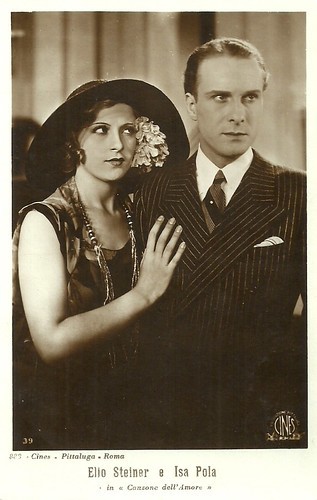
Italian postcard by Ed. G.B. Falci, Milano, no. 39. Photo: Cines. Pittaluga, Roma. Isa Pola and Elio Steiner in La canzone dell'amore/The Song of Love (Gennaro Righelli, 1930).
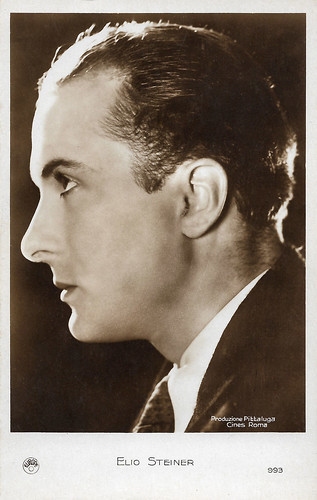
French postcard by Europe, no. 993. Photo: Produzione Pittaluga Cines Roma.
The protagonist of the first Italian sound film
Elio Steiner was born in Stra, Italy, in 1905 as the son of Francesco Steiner and Countess Elena Lupati.
He devoted himself to the theatre when still a teenager. Following his family when they moved to Rome in the first half of the 1920s, he had the opportunity to join, in 1925, the Teatro degli Indipendenti, directed by Anton Giulio Bragaglia.
Subsequently, he made his debut in silent cinema in the short film La chimera del biondo cavaliere/The chimera of the blond knight (1927), followed by the feature film La vena d'oro/The Golden Vein (1929), written and directed by Guglielmo Zorzi. Zorzi made him the protagonist opposite film diva Diana Karenne .
At the end of the twenties, he was, therefore, a young protagonist of Italian silent cinema, among which the drama Assunta Spina (Roberto Roberti, 1929) stood out, in which Rina De Liguoro and Febo Mari had the leads as Assunta and Michele.
But Steiner's real fame came in 1930 when, alongside Dria Paola and Isa Pola , he was the protagonist of the first Italian sound film: La canzone dell'amore/The Song of Love (1930), directed by Gennaro Righelli and shot at the Cines-Pittaluga studios and on location in Rome.
Here, young Lucia (Paola), who has adopted the illegal baby of her mother (who has just died) and pretends to be the baby's mother herself, breaks off her engagement with Enrico (Steiner), a promising singer. Two years after, they meet again when she has become a worker in a record shop. Enrico is still in love with her. After a series of misunderstandings and rivalry by Enrico's other girlfriend Anna (Pola), a happy end follows.
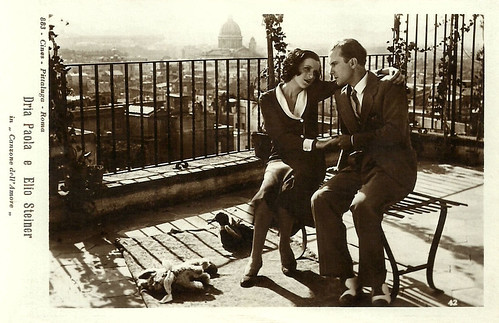
Italian postcard by G.B. Falci, Milano, no. 883. Photo: Cines-Pittaluga, Roma. After an attempted suicide, Lucia ( Dria Paola ) and Enrico (Elio Steiner) make up towards the end of La canzone dell’amore/The Song of Love (Gennaro Righelli, 1930). The cityscape of Rome in the background.
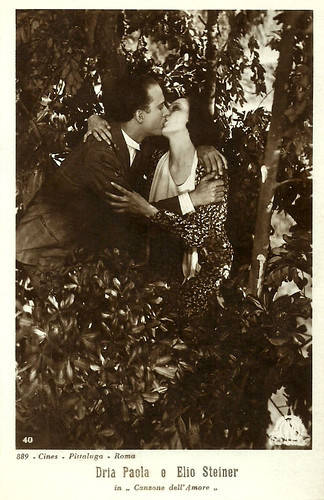
Italian postcard by G.B. Falci, Milano, no. 889. Photo: Cines-Pittaluga, Roma. Lucia ( Dria Paola ) and Enrico (Elio Steiner) hide from their friends in order to be able to kiss each other, in La canzone dell’amore/The Song of Love (Gennaro Righelli, 1930).
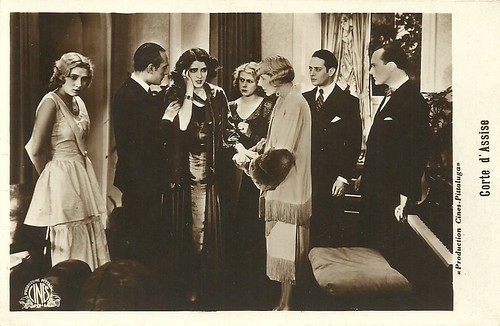
Italian postcard. Photo: Produzione Cines-Pittaluga. From left to right: Lya Franca , Renzo Ricci, Marcella Albani , Mercedes Brignone , and far right Elio Steiner in the courtcase melodrama Corte d'Assise/Court of Assizes (Guido Brignone, 1930), released in 1931.
Increasingly employed in secondary roles
In the early 1930s, Elio Steiner was one of the most popular Italian male actors together with Vittorio De Sica , Nino Besozzi , Gianfranco Giachetti, Sergio Tofano , Carlo Ninchi , and Mino Doro.
After La canzone dell'amore, he immediately acted in a string of films, firstly in Corte d'Assise/Court of Assizes (Guido Brignone, 1930), the first Italian sound film in the detective genre, starring Steiner himself as a reporter investigating a murder and costarring Marcella Albani and Lya Franca .
This was followed by Stella del cinema/Cinema star (Mario Almirante, 1931), where the plot was rather an excuse to showcase the work and the talent at the Cines studios. After that followed e.g. the period piece melodrama Pergolesi (Guido Brignone, 1932), with Dria Paola and Livio Pavanelli , and Acqua cheta/Still water (Gero Zambuto, 1933), starring Gianfranco Giachetti.
In 1934 Elio Steiner temporarily returned to the theatre to perform alongside Uberto Palmarini and Guglielmina Dondi in 'Caterina Sforza' and then returned to the set to act in the films Pensaci, Giacomino!/Think It Over Jack (Gennaro Righelli, 1936) based on a Pirandello play, and Giallo/Yellow (Mario Camerini, 1936).
Progressively Steiner, though, became overshadowed by emerging stars such as Amedeo Nazzari , Fosco Giachetti , Leonardo Cortese , Gino Cervi , Rossano Brazzi , and Raf Vallone , and lost his leading roles. Suffering from incipient baldness, he was increasingly employed in secondary roles, e.g. in the Propaganda film, Giarabub (Goffredo Alessandrini, 1942) about the Italian army besieged in a Libyan fortress by the Britains.
The day after 8 September 1943 he was among the most active in trying to reorganise the Republican film industry in Venice but the outcome was disappointing. Steiner only acted in one released film, Aeroporto (Piero Costa, 1944), mostly shot at Montecatini Terme. The film had only a limited release in early 1945.
Steiner returned to the screen from 1946, first as the evil James Milligan in Senza famiglia/Without Family (Giorgio Ferroni, 1946), He was now confined to character roles. His career would continue with dignity until the end of the fifties, with parts in mostly forgotten films but also La signora senza camelie/Camille Without Camelias (Michelangelo Antonioni, 1953).
Elio Steiner died in 1965 in Rome, Lazio, Italy. He was 61.
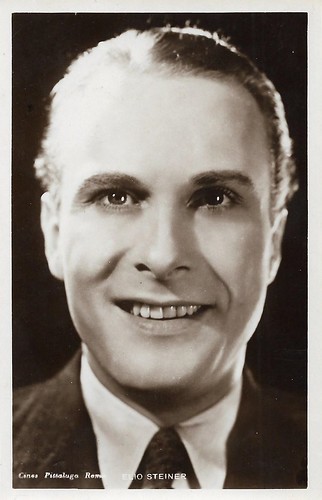
Italian postcard by G.B. Falci, Milano. Photo: Cines-Pittaluga.
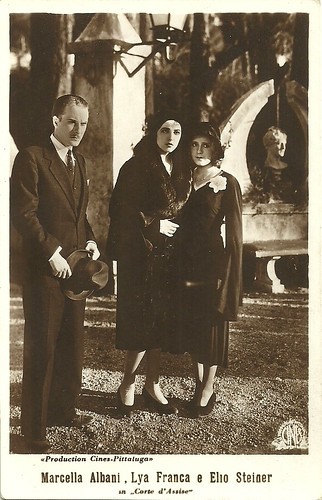
Italian postcard. Photo: Cines-Pittaluga. Marcella Albani , Lya Franca and Elio Steiner in Corte d'Assise (Guido Brignone, 1930), the second Italian sound film, after La canzone dell'amore, and one the first Italian court case crime stories.
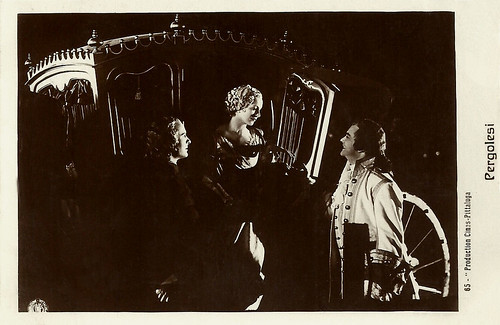
Italian postcard by G.B. Falci, Milano, no. 65. Photo: Cines-Pittaluga. Dria Paola as Maria in Pergolesi (Guido Brignone, 1932). The man left could be Elio Steiner as Pergolesi.
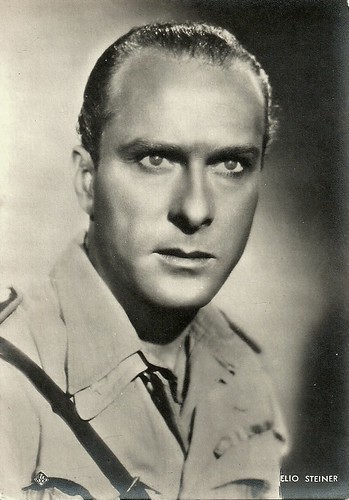
Italian postcard by ASER (A. Scarmiglia Edizioni, Roma), no. 123. Photo: Pesce. Could be for the film Giarabub (1942).
Sources: Wikipedia (Italian and English), and .

Italian postcard by G.B. Falci, Milano. Photo: Cines Pittaluga / ACIEP.

Italian postcard by Ed. G.B. Falci, Milano, no. 39. Photo: Cines. Pittaluga, Roma. Isa Pola and Elio Steiner in La canzone dell'amore/The Song of Love (Gennaro Righelli, 1930).

French postcard by Europe, no. 993. Photo: Produzione Pittaluga Cines Roma.
The protagonist of the first Italian sound film
Elio Steiner was born in Stra, Italy, in 1905 as the son of Francesco Steiner and Countess Elena Lupati.
He devoted himself to the theatre when still a teenager. Following his family when they moved to Rome in the first half of the 1920s, he had the opportunity to join, in 1925, the Teatro degli Indipendenti, directed by Anton Giulio Bragaglia.
Subsequently, he made his debut in silent cinema in the short film La chimera del biondo cavaliere/The chimera of the blond knight (1927), followed by the feature film La vena d'oro/The Golden Vein (1929), written and directed by Guglielmo Zorzi. Zorzi made him the protagonist opposite film diva Diana Karenne .
At the end of the twenties, he was, therefore, a young protagonist of Italian silent cinema, among which the drama Assunta Spina (Roberto Roberti, 1929) stood out, in which Rina De Liguoro and Febo Mari had the leads as Assunta and Michele.
But Steiner's real fame came in 1930 when, alongside Dria Paola and Isa Pola , he was the protagonist of the first Italian sound film: La canzone dell'amore/The Song of Love (1930), directed by Gennaro Righelli and shot at the Cines-Pittaluga studios and on location in Rome.
Here, young Lucia (Paola), who has adopted the illegal baby of her mother (who has just died) and pretends to be the baby's mother herself, breaks off her engagement with Enrico (Steiner), a promising singer. Two years after, they meet again when she has become a worker in a record shop. Enrico is still in love with her. After a series of misunderstandings and rivalry by Enrico's other girlfriend Anna (Pola), a happy end follows.

Italian postcard by G.B. Falci, Milano, no. 883. Photo: Cines-Pittaluga, Roma. After an attempted suicide, Lucia ( Dria Paola ) and Enrico (Elio Steiner) make up towards the end of La canzone dell’amore/The Song of Love (Gennaro Righelli, 1930). The cityscape of Rome in the background.

Italian postcard by G.B. Falci, Milano, no. 889. Photo: Cines-Pittaluga, Roma. Lucia ( Dria Paola ) and Enrico (Elio Steiner) hide from their friends in order to be able to kiss each other, in La canzone dell’amore/The Song of Love (Gennaro Righelli, 1930).

Italian postcard. Photo: Produzione Cines-Pittaluga. From left to right: Lya Franca , Renzo Ricci, Marcella Albani , Mercedes Brignone , and far right Elio Steiner in the courtcase melodrama Corte d'Assise/Court of Assizes (Guido Brignone, 1930), released in 1931.
Increasingly employed in secondary roles
In the early 1930s, Elio Steiner was one of the most popular Italian male actors together with Vittorio De Sica , Nino Besozzi , Gianfranco Giachetti, Sergio Tofano , Carlo Ninchi , and Mino Doro.
After La canzone dell'amore, he immediately acted in a string of films, firstly in Corte d'Assise/Court of Assizes (Guido Brignone, 1930), the first Italian sound film in the detective genre, starring Steiner himself as a reporter investigating a murder and costarring Marcella Albani and Lya Franca .
This was followed by Stella del cinema/Cinema star (Mario Almirante, 1931), where the plot was rather an excuse to showcase the work and the talent at the Cines studios. After that followed e.g. the period piece melodrama Pergolesi (Guido Brignone, 1932), with Dria Paola and Livio Pavanelli , and Acqua cheta/Still water (Gero Zambuto, 1933), starring Gianfranco Giachetti.
In 1934 Elio Steiner temporarily returned to the theatre to perform alongside Uberto Palmarini and Guglielmina Dondi in 'Caterina Sforza' and then returned to the set to act in the films Pensaci, Giacomino!/Think It Over Jack (Gennaro Righelli, 1936) based on a Pirandello play, and Giallo/Yellow (Mario Camerini, 1936).
Progressively Steiner, though, became overshadowed by emerging stars such as Amedeo Nazzari , Fosco Giachetti , Leonardo Cortese , Gino Cervi , Rossano Brazzi , and Raf Vallone , and lost his leading roles. Suffering from incipient baldness, he was increasingly employed in secondary roles, e.g. in the Propaganda film, Giarabub (Goffredo Alessandrini, 1942) about the Italian army besieged in a Libyan fortress by the Britains.
The day after 8 September 1943 he was among the most active in trying to reorganise the Republican film industry in Venice but the outcome was disappointing. Steiner only acted in one released film, Aeroporto (Piero Costa, 1944), mostly shot at Montecatini Terme. The film had only a limited release in early 1945.
Steiner returned to the screen from 1946, first as the evil James Milligan in Senza famiglia/Without Family (Giorgio Ferroni, 1946), He was now confined to character roles. His career would continue with dignity until the end of the fifties, with parts in mostly forgotten films but also La signora senza camelie/Camille Without Camelias (Michelangelo Antonioni, 1953).
Elio Steiner died in 1965 in Rome, Lazio, Italy. He was 61.

Italian postcard by G.B. Falci, Milano. Photo: Cines-Pittaluga.

Italian postcard. Photo: Cines-Pittaluga. Marcella Albani , Lya Franca and Elio Steiner in Corte d'Assise (Guido Brignone, 1930), the second Italian sound film, after La canzone dell'amore, and one the first Italian court case crime stories.

Italian postcard by G.B. Falci, Milano, no. 65. Photo: Cines-Pittaluga. Dria Paola as Maria in Pergolesi (Guido Brignone, 1932). The man left could be Elio Steiner as Pergolesi.

Italian postcard by ASER (A. Scarmiglia Edizioni, Roma), no. 123. Photo: Pesce. Could be for the film Giarabub (1942).
Sources: Wikipedia (Italian and English), and .
Published on August 17, 2021 22:00
August 16, 2021
Margarita Terekhova
Margarita Terekhova (1942) is a Soviet and Russian film and theatre actress. She is internationally best-known for her dual role in Andrei Tarkovsky's film Serkalo/Mirror (1975).
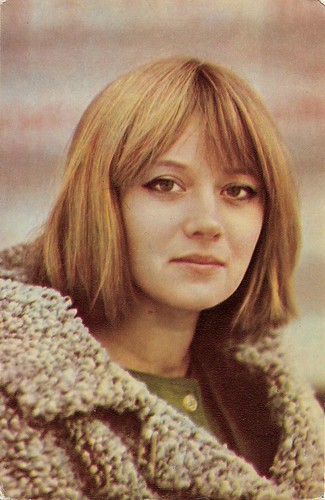
Soviet-Russian postcard by Bjuro Propagandy Sovetskogo Kinoiskusstva, 1973.
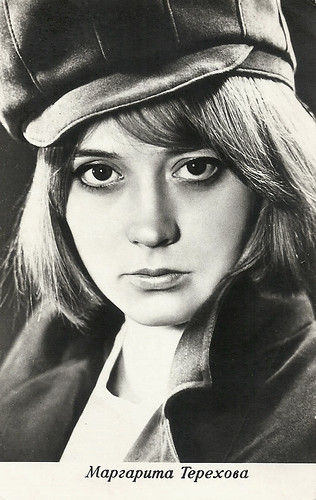
Soviet-Russian postcard. Photo: G. Ter-Ovanesova.
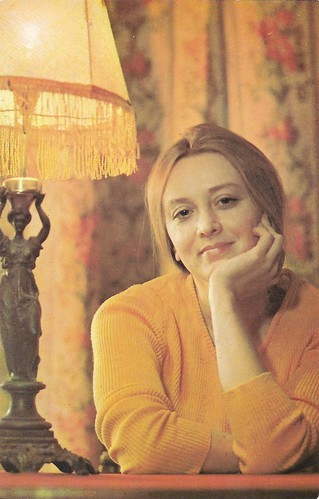
Russian postcard by Bjuro Propagandy Sovetskogo Kinoiskusstva, 1978. Photo: B. Bondareva.
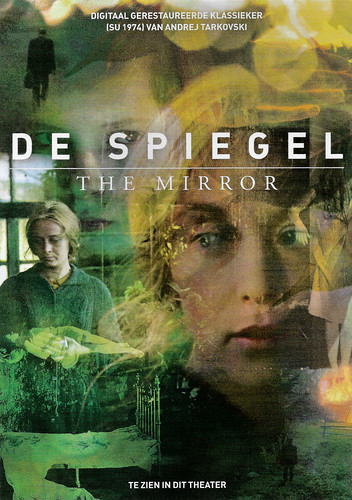
Dutch postcard by Eye. Dutch poster for Zerkalo/The Mirror (Andrei Tarkovsky, 1975). The title in Dutch is 'De spiegel'. Caption: Digitally restored classic (Sovet Union, 1974) of Andrei Tarkovsky.
Cleopatra
Margarita Terekhova (Russian: Маргари́та Бори́совна Те́рехова) was born in 1942 in Turinsk, Sverdlovsk Oblast, Russian SFSR. Her parents were Boris Terekhov, an actor of the Sverdlovsk Theater, and actress Galina Stanislavovna Tomasevic. In school, Margarita was interested in sport and was a basketball captain.
After finishing school with a gold medal, Margarita studied at the physics and mathematics faculty at the National University of Uzbekistan in Tashkent from 1959 until 1961. Then, she left everything behind and went to Moscow, where she applied to the WGIK, but was rejected.
Instead, she trained at the drama studio of director Yuri Zavadsky in the Mossovet Theatre in Moscow until 1964, when she joined the troupe of this theatre. While still a student, she played Cleopatra in George Bernard Shaw's 'Caesar and Cleopatra' in 1964.
Terekhova's film career began in 1965 with the Armenian film Barev, yes em (Здравствуй, это я!)/Hello, it's me! (Frunze Dovlatyan, 1965). The film is based on the biography of Artem Alikhanian, a famous physicist and founder of a cosmology laboratory in Aragats. The film was entered into the 1966 Cannes Film Festival, nominated to Palme d'Or, and awarded the State Prize of Armenia in 1967.
Margarita Terekhova continued her film career with the dramas Belorusski vokzal/Belarus Station (Andrei Smirnov, 1970), and Monolog/Monologue (Ilya Awerbach, 1972), which was entered into the 1973 Cannes Film Festival.
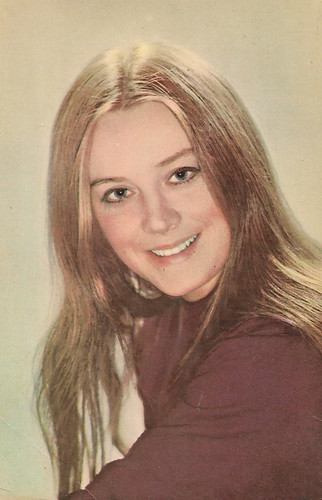
Soviet-Russian postcard by Bjuro Propagandy Sovetskogo Kinoiskusstva, 1971.
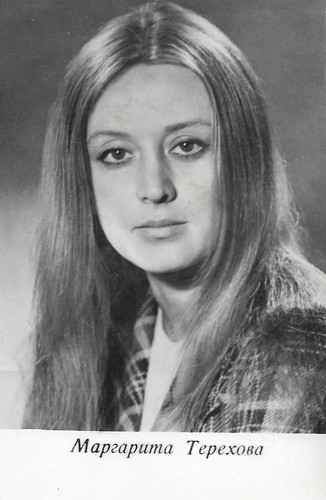
Soviet-Russian/Ukrainian postcard by Ukrreklamfilm, Kiev, 1973.
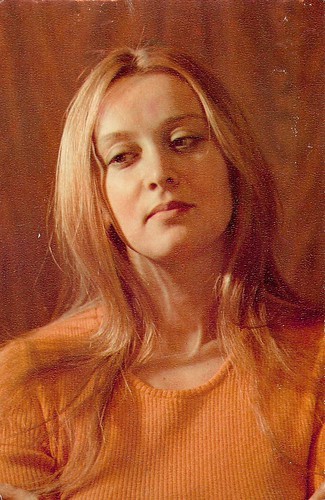
Soviet-Russian postcard. Photo: B. Bondareva, Caption on the back: "The Wonderful Artist of the RSFSR", 1978.
Milady de Winter
In 1975, Margarita Terekhova played a dual role in Andrei Tarkovsky's acclaimed art film Zerkalo (Зеркало)/The Mirror (Andrei Tarkovsky, 1975). It is loosely autobiographical, unconventionally structured, and incorporates poems composed and read by the director's father, Arseny Tarkovsky. The Mirror initially polarised critics and audiences, with many considering its narrative to be incomprehensible. The work has grown in reputation since its release and is now considered one of the greatest films of all time. Tarkovsky also directed her on stage as Gertrud in 'Hamlet' (1977).
Her next film was the Finnish-Soviet historical drama Doverie/Trust (Edvin Laine and Viktor Tregubovich, 1976) which portrays the events leading up to the Finnish Declaration of Independence from Russia in 1917. Terekhova also worked in international co-productions such as in the children's fantasy film The Blue Bird (George Cukor, 1976), starring Elizabeth Taylor and Jane Fonda , and the East-German film Mama, ich lebe/Mama, I'm Alive (Konrad Wolf, 1977) with Donatas Banionis .
Terekhova was also popular in the Soviet Union for her roles on television, including Masha in My Life (1972) based on Anton Chekhov, and Countess Diana in Sobaka na sene/The Dog in the Manger (Yan Frid, 1977) based on the eponymous 1618 play by Lope de Vega.
She gained national fame with her role as Milady de Winter in D'Artanyan i tri mushketera/D'Artagnan and the Three Musketeers (Georgi Yungvald-Khilkevich, 1978), based on the 1844 novel 'The Three Musketeers' by Alexandre Dumas, père. The Mini-series contained numerous songs that became extremely popular in the Soviet Union throughout the late 1970s and early 1980s, and the series is now considered a classic.
In 1983, together with Igor Talkov, Terekhova set up her own theatre group 'Balagantchik' (The Puppet Show) where she performed until 1986. She then returned to the Mossovet theater. In 1996, the actress was named People's Artist of the Russian Federation.
As a director, she staged Gabriel Garcia Lorca's 'Once Five Years Pass' and Alexander Ostrovsky's 'The Guiltlessly Guilty' (Без вины виноватые) at the Mossoviet Theater. In 2005, she directed a film adaptation of Anton Chekhov's The Seagull (Чайка).
Terekhova was married three times. Her first husband (1964-1967) was the actor Vyacheslav Butenko. From 1967 till 1969, she was married to the Bulgarian actor Savva Kirillovich Hashimov and her third husband (1980-1995) was director Georgiy Yurievich Gavrilov. She has a daughter, actress Anna Terekhova (1967 or 1970), from second husband Savva Hashimov. Her son is actor and artist Alexander Terekhov (1981). His father is Georgiy Gavrilov.
Since 2011, Margarita Terekhova is suffering from Alzheimer's disease. She does not leave her home anymore and does not give interviews. In 2013, she was awarded the Order of Honor for her life's work.
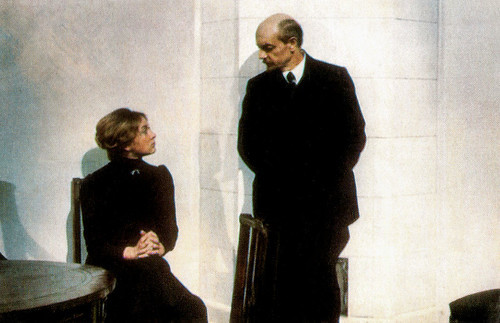
Soviet-Russian postcard by Len. Otdelenie Bjuro Propagandy Sovetskogo Kinoiskusstva, no. 109/76, 1976. Kirill Lavrov and Margarita Terekhova in Doverie/Trust (Edvin Laine, Viktor Tregubovich, 1976). The postcard was issued in 200,000 copies. Retail price: 5 Kop.
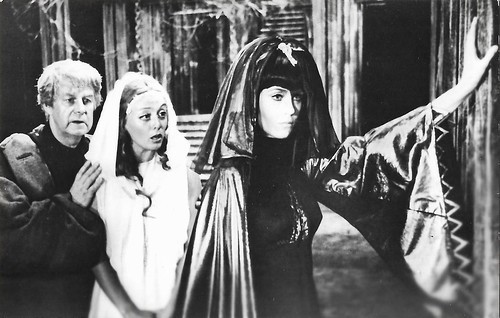
Soviet-Russian postcard, issued by Patvinskoe Otdelenie Bjuro Propagandy Sovetskogo Kinoiskusstva, Riga, 1977, no. 2119783. Margarita Terekhova as Milk and Jane Fonda as The Night in the American-Russian coproduction The Blue Bird (George Cukor, 1976). The man behind them is Richard Pearson, who plays Bread.
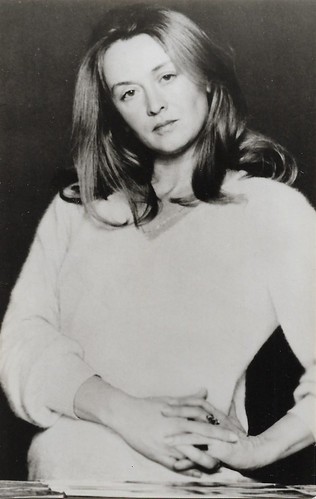
Soviet-Russian postcard by Bjuro Propagandy Sovetskogo Kinoiskusstva, 1983.
Sources: Wikipedia (German and English), and .

Soviet-Russian postcard by Bjuro Propagandy Sovetskogo Kinoiskusstva, 1973.

Soviet-Russian postcard. Photo: G. Ter-Ovanesova.

Russian postcard by Bjuro Propagandy Sovetskogo Kinoiskusstva, 1978. Photo: B. Bondareva.

Dutch postcard by Eye. Dutch poster for Zerkalo/The Mirror (Andrei Tarkovsky, 1975). The title in Dutch is 'De spiegel'. Caption: Digitally restored classic (Sovet Union, 1974) of Andrei Tarkovsky.
Cleopatra
Margarita Terekhova (Russian: Маргари́та Бори́совна Те́рехова) was born in 1942 in Turinsk, Sverdlovsk Oblast, Russian SFSR. Her parents were Boris Terekhov, an actor of the Sverdlovsk Theater, and actress Galina Stanislavovna Tomasevic. In school, Margarita was interested in sport and was a basketball captain.
After finishing school with a gold medal, Margarita studied at the physics and mathematics faculty at the National University of Uzbekistan in Tashkent from 1959 until 1961. Then, she left everything behind and went to Moscow, where she applied to the WGIK, but was rejected.
Instead, she trained at the drama studio of director Yuri Zavadsky in the Mossovet Theatre in Moscow until 1964, when she joined the troupe of this theatre. While still a student, she played Cleopatra in George Bernard Shaw's 'Caesar and Cleopatra' in 1964.
Terekhova's film career began in 1965 with the Armenian film Barev, yes em (Здравствуй, это я!)/Hello, it's me! (Frunze Dovlatyan, 1965). The film is based on the biography of Artem Alikhanian, a famous physicist and founder of a cosmology laboratory in Aragats. The film was entered into the 1966 Cannes Film Festival, nominated to Palme d'Or, and awarded the State Prize of Armenia in 1967.
Margarita Terekhova continued her film career with the dramas Belorusski vokzal/Belarus Station (Andrei Smirnov, 1970), and Monolog/Monologue (Ilya Awerbach, 1972), which was entered into the 1973 Cannes Film Festival.

Soviet-Russian postcard by Bjuro Propagandy Sovetskogo Kinoiskusstva, 1971.

Soviet-Russian/Ukrainian postcard by Ukrreklamfilm, Kiev, 1973.

Soviet-Russian postcard. Photo: B. Bondareva, Caption on the back: "The Wonderful Artist of the RSFSR", 1978.
Milady de Winter
In 1975, Margarita Terekhova played a dual role in Andrei Tarkovsky's acclaimed art film Zerkalo (Зеркало)/The Mirror (Andrei Tarkovsky, 1975). It is loosely autobiographical, unconventionally structured, and incorporates poems composed and read by the director's father, Arseny Tarkovsky. The Mirror initially polarised critics and audiences, with many considering its narrative to be incomprehensible. The work has grown in reputation since its release and is now considered one of the greatest films of all time. Tarkovsky also directed her on stage as Gertrud in 'Hamlet' (1977).
Her next film was the Finnish-Soviet historical drama Doverie/Trust (Edvin Laine and Viktor Tregubovich, 1976) which portrays the events leading up to the Finnish Declaration of Independence from Russia in 1917. Terekhova also worked in international co-productions such as in the children's fantasy film The Blue Bird (George Cukor, 1976), starring Elizabeth Taylor and Jane Fonda , and the East-German film Mama, ich lebe/Mama, I'm Alive (Konrad Wolf, 1977) with Donatas Banionis .
Terekhova was also popular in the Soviet Union for her roles on television, including Masha in My Life (1972) based on Anton Chekhov, and Countess Diana in Sobaka na sene/The Dog in the Manger (Yan Frid, 1977) based on the eponymous 1618 play by Lope de Vega.
She gained national fame with her role as Milady de Winter in D'Artanyan i tri mushketera/D'Artagnan and the Three Musketeers (Georgi Yungvald-Khilkevich, 1978), based on the 1844 novel 'The Three Musketeers' by Alexandre Dumas, père. The Mini-series contained numerous songs that became extremely popular in the Soviet Union throughout the late 1970s and early 1980s, and the series is now considered a classic.
In 1983, together with Igor Talkov, Terekhova set up her own theatre group 'Balagantchik' (The Puppet Show) where she performed until 1986. She then returned to the Mossovet theater. In 1996, the actress was named People's Artist of the Russian Federation.
As a director, she staged Gabriel Garcia Lorca's 'Once Five Years Pass' and Alexander Ostrovsky's 'The Guiltlessly Guilty' (Без вины виноватые) at the Mossoviet Theater. In 2005, she directed a film adaptation of Anton Chekhov's The Seagull (Чайка).
Terekhova was married three times. Her first husband (1964-1967) was the actor Vyacheslav Butenko. From 1967 till 1969, she was married to the Bulgarian actor Savva Kirillovich Hashimov and her third husband (1980-1995) was director Georgiy Yurievich Gavrilov. She has a daughter, actress Anna Terekhova (1967 or 1970), from second husband Savva Hashimov. Her son is actor and artist Alexander Terekhov (1981). His father is Georgiy Gavrilov.
Since 2011, Margarita Terekhova is suffering from Alzheimer's disease. She does not leave her home anymore and does not give interviews. In 2013, she was awarded the Order of Honor for her life's work.

Soviet-Russian postcard by Len. Otdelenie Bjuro Propagandy Sovetskogo Kinoiskusstva, no. 109/76, 1976. Kirill Lavrov and Margarita Terekhova in Doverie/Trust (Edvin Laine, Viktor Tregubovich, 1976). The postcard was issued in 200,000 copies. Retail price: 5 Kop.

Soviet-Russian postcard, issued by Patvinskoe Otdelenie Bjuro Propagandy Sovetskogo Kinoiskusstva, Riga, 1977, no. 2119783. Margarita Terekhova as Milk and Jane Fonda as The Night in the American-Russian coproduction The Blue Bird (George Cukor, 1976). The man behind them is Richard Pearson, who plays Bread.

Soviet-Russian postcard by Bjuro Propagandy Sovetskogo Kinoiskusstva, 1983.
Sources: Wikipedia (German and English), and .
Published on August 16, 2021 22:00
August 15, 2021
Cyril Maude
Cyril Maude (1862-1951) was a famous English actor-manager. From 1914 on, he appeared in several British and American films.
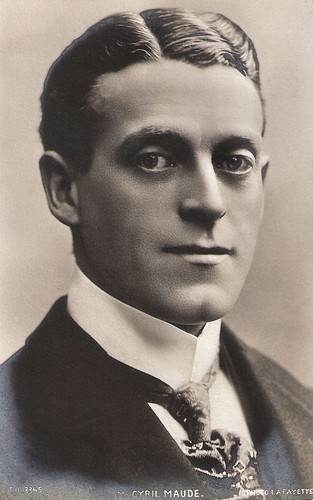
British postcard, no. 3345. Photo: La Fayette.

British postcard by J. Beagles & Co., no. 184 D. Photo: Dover Street Studios. C. Aubrey Smith and Cyril Maude in the play 'The Flag Lieutenant' (1908).
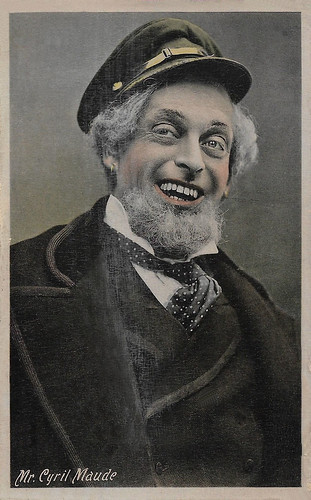
British postcard. Cyril Maude as Captain Barley in the play 'Beauty and the Barge' (first performed in 1904). This card was mailed in 1905. In 1914 Maude would debut on screen in an eponymous adaptation of the play, directed by Harold M. Shaw.
Grumpy
Cyril Francis Maude was born in London in 1862. Maude was the eldest son of Captain Charles Henry Maude, a captain in the Indian Army, and the Honorable Georgina Hanbury-Tracy. His maternal grandfather was Thomas Hanbury-Tracy, 2nd Baron Sudeley. In 1881, Cyril was sent to Adelaide, South Australia, on the clipper ship City of Adelaide to regain his health. He returned to Britain without having regained his health but nursing the ambition to be an actor.
He studied theatre under Charles Cartwright and Roma Le Thiere but was again forced to leave Britain for ill-health and went to Canada. Afterward, he went to the US, where he debuted with Daniel Bandman's company in Denver, Colorado, in 1884. The same year he went back to Britain and had a long-lasting, glorious career.
From 1896 until 1905 he was co-manager of the Haymarket Theatre in London with Frederick Harrison. There he became known for his quietly humorous acting in many parts. In 1906 he went into management on his own account, and in 1907 he opened the Playhouse, also in London
Maude became very well known for his role in 'Grumpy' as a spoiled old man, who as a retired lawyer solves a crime to keep his loved ones happy. Maude took this play to Australia and toured Adelaide, Melbourne, Brisbane, and Sydney where it was immensely popular.
In 1923 he toured America with Lydia Bilbrook and Mabel Terry-Lewis in 'If Winter Comes', playing at Chicago in April and New York in the autumn.
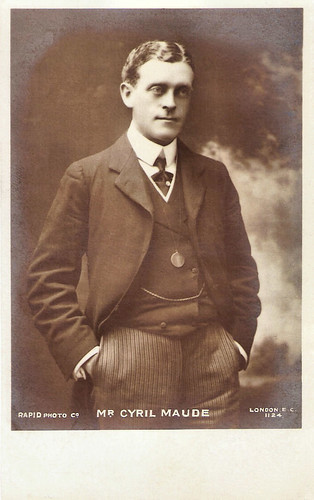
British postcard by Rapid Photo Co., London, no. 1124.
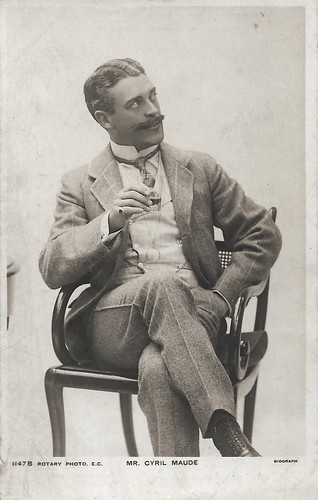
British postcard by Rotary Photo, no. E.C. 1147 B. Photo: Biograph. Cyril Maude as Sir Joseph Lacy in 'Joseph Entangled', first performed in Britain in 1904.

British postcard by Rotary Photo, no. E.C. 1147 C. Photo: Biograph.
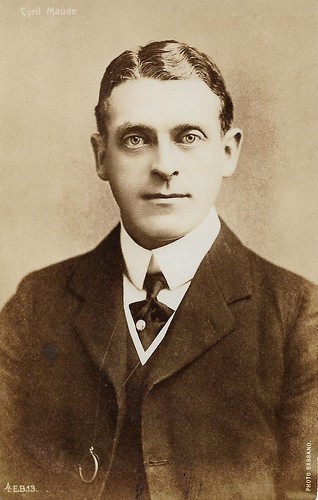
British postcard by AL, no. E.B.13. Photo: Bassano.
Paramount
In 1914, Cyril Maude debuted on-screen in an adaptation of his successful play Beauty and the Barge (Harold Shaw, 1914), in which he played an old barge captain who adopts the mayor's runaway daughter and she falls in love with his mate.
In the US he starred in the title role of the Henrik Ibsen adaptation Peer Gynt (Oscar Apfel, Raoul Walsh, 1915), with Myrtle Stedman as Solveig. The film was produced by the Oliver Morosco Photoplay Company and distributed by Paramount. In the drama The Greater Will (Harry Knoles, 1915) Maude takes revenge on the man (Montague Love) who hypnotised his own daughter (Lois Meredith), whom he ruined and pushed to suicide.
For the Stage Women's War Relief Fund, Maude starred in Winning His Wife (George Terwilliger, 1919). Maude's last silent part was in the British comedy-drama The Headmaster (Kenelm Foss, 1921), in which he is the headmaster of a school who tries to persuade his daughter (Margot Drake) to marry the idiotic son of an influential figure in the hope of being promoted to bishop.
When sound cinema set in, Maude acted in several films, first of all, the adaptation of his famous play Grumpy (George Cukor (his debut), Cyril Gardner, 1930), filmed in the U.S. and released by Paramount Pictures. The film also featured Frances Dade, Philips Holmes, and Paul Lukas .
Afterward, he acted in the British Paramount film These Charming People (Louis Mercanton, 1931) with Godfrey Tearle, the British films Counsel's Opinion (Allan Dwan, 1933) starring Henry Kendall and Binnie Barnes, the comedy Orders Is Orders (Walter Forde, 1933) starring Charlotte Greenwood and James Gleason, the cross-dressing comedy Girls Will Be Boys (Marcel Varnel, 1934) starring Dolly Haas , and the musical comedy Heat Wave (Maurice Elvey, 1935). After an absence from the screen for over a decade, Maude played one final role as an old admiral in While the Sun Shines (Anthony Asquith, 1947). He was 85 at the time.
Cyril Maude died in Torquay, Devon in 1951, at the age of 88. From 1888 till 1924, he was married to the actress Winifred Emery, the daughter of Samuel Anderson Emery and granddaughter of John Emery, both well-known actors in their day. Their children included Margery Maude, who became an actress; Pamela Cynthia Maude (1893–1975); and John Cyril Maude, who became a barrister, judge, and Member of Parliament. Cyril Maude married Mrs. P.H. Trew in 1927. They remained together till his death.
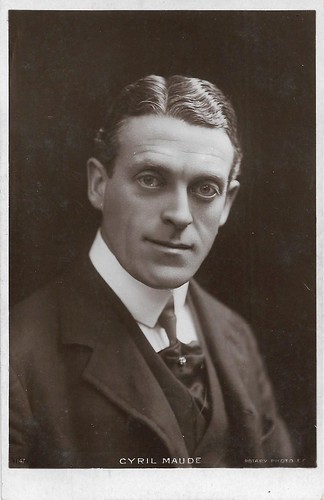
British postcard by Rotary Photo, no. 1147.
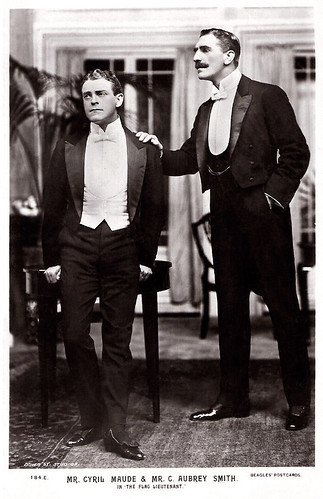
British postcard by J. Beagles & Co. Ltd., London, no. 184E. Photo: Dover St. Studios. Publicity still for the play The Flag Lieutenant with Cyril Maude as Lieutenant Richard Lascelles and C. Aubrey Smith as Major Thesiger at The Playhouse, 1908.
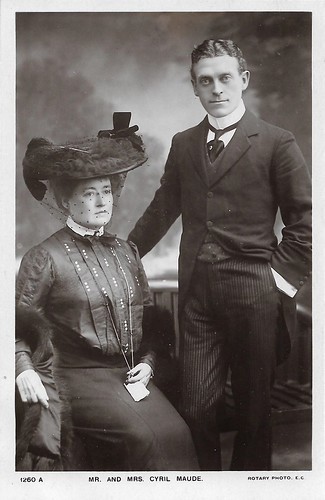
British postcard by Rotary Photo, no. E.C. 1260 A. Mr. and Mrs. Cyril Maude (Miss Winifred Emery).
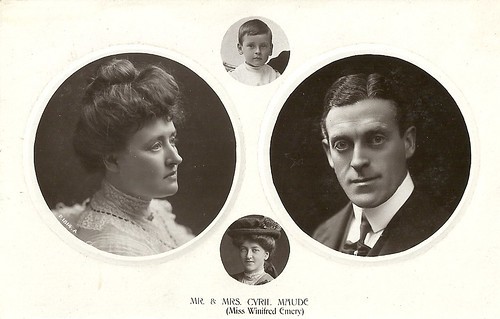
British postcard in the Rotary Photographic Circle Plate Sunk Series. Mr. and Mrs. Cyril Maude (Miss Winifred Emery).
Sources: Wikipedia and .

British postcard, no. 3345. Photo: La Fayette.

British postcard by J. Beagles & Co., no. 184 D. Photo: Dover Street Studios. C. Aubrey Smith and Cyril Maude in the play 'The Flag Lieutenant' (1908).

British postcard. Cyril Maude as Captain Barley in the play 'Beauty and the Barge' (first performed in 1904). This card was mailed in 1905. In 1914 Maude would debut on screen in an eponymous adaptation of the play, directed by Harold M. Shaw.
Grumpy
Cyril Francis Maude was born in London in 1862. Maude was the eldest son of Captain Charles Henry Maude, a captain in the Indian Army, and the Honorable Georgina Hanbury-Tracy. His maternal grandfather was Thomas Hanbury-Tracy, 2nd Baron Sudeley. In 1881, Cyril was sent to Adelaide, South Australia, on the clipper ship City of Adelaide to regain his health. He returned to Britain without having regained his health but nursing the ambition to be an actor.
He studied theatre under Charles Cartwright and Roma Le Thiere but was again forced to leave Britain for ill-health and went to Canada. Afterward, he went to the US, where he debuted with Daniel Bandman's company in Denver, Colorado, in 1884. The same year he went back to Britain and had a long-lasting, glorious career.
From 1896 until 1905 he was co-manager of the Haymarket Theatre in London with Frederick Harrison. There he became known for his quietly humorous acting in many parts. In 1906 he went into management on his own account, and in 1907 he opened the Playhouse, also in London
Maude became very well known for his role in 'Grumpy' as a spoiled old man, who as a retired lawyer solves a crime to keep his loved ones happy. Maude took this play to Australia and toured Adelaide, Melbourne, Brisbane, and Sydney where it was immensely popular.
In 1923 he toured America with Lydia Bilbrook and Mabel Terry-Lewis in 'If Winter Comes', playing at Chicago in April and New York in the autumn.

British postcard by Rapid Photo Co., London, no. 1124.

British postcard by Rotary Photo, no. E.C. 1147 B. Photo: Biograph. Cyril Maude as Sir Joseph Lacy in 'Joseph Entangled', first performed in Britain in 1904.

British postcard by Rotary Photo, no. E.C. 1147 C. Photo: Biograph.

British postcard by AL, no. E.B.13. Photo: Bassano.
Paramount
In 1914, Cyril Maude debuted on-screen in an adaptation of his successful play Beauty and the Barge (Harold Shaw, 1914), in which he played an old barge captain who adopts the mayor's runaway daughter and she falls in love with his mate.
In the US he starred in the title role of the Henrik Ibsen adaptation Peer Gynt (Oscar Apfel, Raoul Walsh, 1915), with Myrtle Stedman as Solveig. The film was produced by the Oliver Morosco Photoplay Company and distributed by Paramount. In the drama The Greater Will (Harry Knoles, 1915) Maude takes revenge on the man (Montague Love) who hypnotised his own daughter (Lois Meredith), whom he ruined and pushed to suicide.
For the Stage Women's War Relief Fund, Maude starred in Winning His Wife (George Terwilliger, 1919). Maude's last silent part was in the British comedy-drama The Headmaster (Kenelm Foss, 1921), in which he is the headmaster of a school who tries to persuade his daughter (Margot Drake) to marry the idiotic son of an influential figure in the hope of being promoted to bishop.
When sound cinema set in, Maude acted in several films, first of all, the adaptation of his famous play Grumpy (George Cukor (his debut), Cyril Gardner, 1930), filmed in the U.S. and released by Paramount Pictures. The film also featured Frances Dade, Philips Holmes, and Paul Lukas .
Afterward, he acted in the British Paramount film These Charming People (Louis Mercanton, 1931) with Godfrey Tearle, the British films Counsel's Opinion (Allan Dwan, 1933) starring Henry Kendall and Binnie Barnes, the comedy Orders Is Orders (Walter Forde, 1933) starring Charlotte Greenwood and James Gleason, the cross-dressing comedy Girls Will Be Boys (Marcel Varnel, 1934) starring Dolly Haas , and the musical comedy Heat Wave (Maurice Elvey, 1935). After an absence from the screen for over a decade, Maude played one final role as an old admiral in While the Sun Shines (Anthony Asquith, 1947). He was 85 at the time.
Cyril Maude died in Torquay, Devon in 1951, at the age of 88. From 1888 till 1924, he was married to the actress Winifred Emery, the daughter of Samuel Anderson Emery and granddaughter of John Emery, both well-known actors in their day. Their children included Margery Maude, who became an actress; Pamela Cynthia Maude (1893–1975); and John Cyril Maude, who became a barrister, judge, and Member of Parliament. Cyril Maude married Mrs. P.H. Trew in 1927. They remained together till his death.

British postcard by Rotary Photo, no. 1147.

British postcard by J. Beagles & Co. Ltd., London, no. 184E. Photo: Dover St. Studios. Publicity still for the play The Flag Lieutenant with Cyril Maude as Lieutenant Richard Lascelles and C. Aubrey Smith as Major Thesiger at The Playhouse, 1908.

British postcard by Rotary Photo, no. E.C. 1260 A. Mr. and Mrs. Cyril Maude (Miss Winifred Emery).

British postcard in the Rotary Photographic Circle Plate Sunk Series. Mr. and Mrs. Cyril Maude (Miss Winifred Emery).
Sources: Wikipedia and .
Published on August 15, 2021 22:00
August 14, 2021
Three early silent films starring Theodor Loos
German stage and screen actor Theodor Loos (1883-1954) is now best-known for his parts in Fritz Lang’s German films. Loos played his first film part already in 1913 and soon followed several more films by renowned directors such as Richard Oswald, Stellan Rye, Robert Wiene, Otto Rippert, and Robert Reinert. For this post, we selected three of his early silent films. All were made in one year for one production company and by the same director: Die singende Hand/The Singing Hand (Arthur Wellin, 1918), Die Buße des Richard Solm/The Penance of Richard Solm (Arthur Wellin, 1918), and Getrennte Welten/Separated Worlds (Arthur Wellin, 1918).
Die singende Hand (1918)
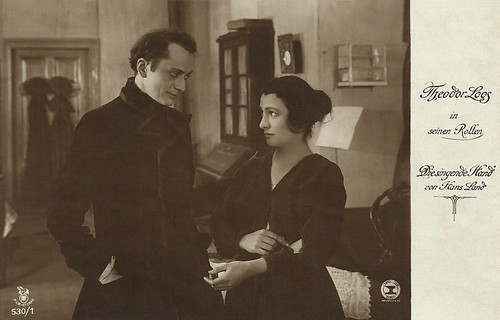
German postcard in the Film-Sterne series by Rotophot, no. 530/1. Photo: Amboß-Film Dworsky & Co., Berlin. Theodor Loos as the violin player Leonid Heller in Die singende Hand/The Singing Hand (Arthur Wellin, 1918). The woman is Eva Speyer.
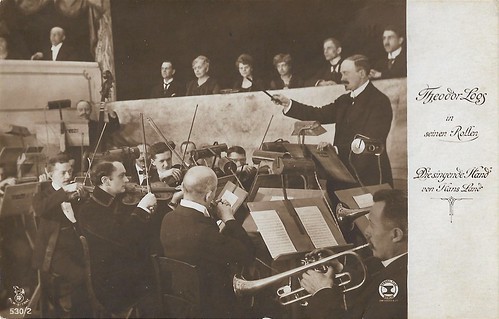
German postcard in the Film-Sterne series by Rotophot, no. 530/2. Photo: Amboß-Film Dworsky & Co., Berlin. Theodor Loos in Die singende Hand/The Singing Hand (Arthur Wellin, 1918).
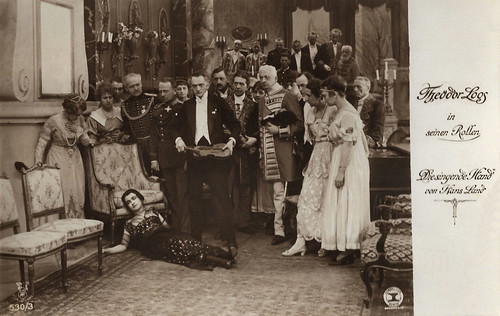
German postcard in the Film-Sterne series by Rotophot, no. 530/3. Photo: Amboß-Film Dworsky & Co., Berlin. Theodor Loos in Die singende Hand/The Singing Hand (Arthur Wellin, 1918). The woman on the ground is Eva Speyer as Esther. The man left of Loos is Otto Gebühr , playing the Duke of Gralby.
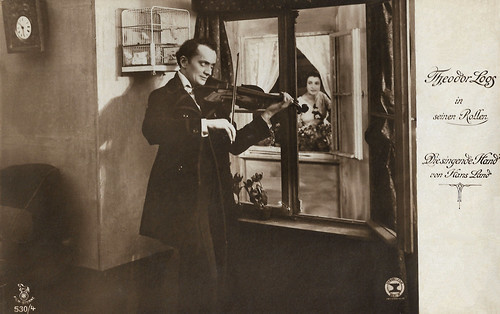
German postcard in the Film-Sterne series by Rotophot, no. 530/4. Photo: Amboß-Film Dworsky & Co., Berlin. Theodor Loos in Die singende Hand/The Singing Hand (Arthur Wellin, 1918). The woman is Eva Speyer.
Who were Hugo Landsberger and Arthur Wellin?
Die Singende Hand/The Singing Hand (Arthur Wellin, 1918) was scripted by Hans Land, the pseudonym of Hugo Landsberger. Some sources erroneously mention the film was based on a novel by Hans Lau, but it was Landsberger who in hindsight in 1926 published his script as a novel, edited by Oestergaard. The producer, Rudolf Dworsky, was also responsible for the set design.
Hugo Landsberger (1861-reported missing 1938) was a Jewish writer, who produced several socially engaged short stories, books, and plays under the pseudonym of Hans Land, while he also produced popular entertainment works such as 'Stürme' (1909) and 'Staatsanwalt Jordan' (1915). From 1913 he also wrote various film scripts. Land also acted occasionally and directed the film Stürme (1913), based on his own work.
Arthur Wellin (1880-prob. 1941) was a Jewish film director, originally Arthur Lewin. He had been a prolific stage director before shifting to film, the reason for Austrian actor Alexander Moissi to engage him as a film director for 5 films between 1918 and 1920.
Wellin was also co-owner of Ambross-Film, with Dworsky. All in all, he directed some 27 silent films, and at times also acted. In 1933 he was expelled from acting when Hitler took over in Germany. In 1941 he was deported from Prague to the Lodz ghetto in Poland, and from there probably sent to one of the extermination camps.
The film Die Singende Hand/The Singing Hand (Arthur Wellin, 1918) premiered in Berlin in May 1918.
Die Buße des Richard Solm (1918)
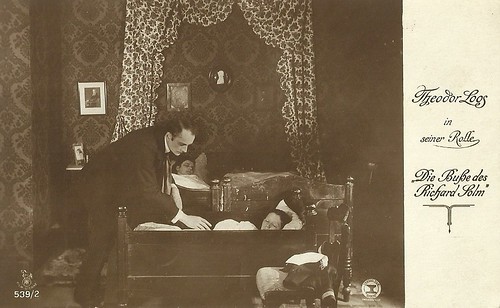
German postcard in the Film-Sterne series by Rotophot, no. 539/2. Photo: Amboß-Film Dworsky & Co., Berlin. Theodor Loos in Die Buße des Richard Solm/The Penance of Richard Solm (Arthur Wellin, 1918).
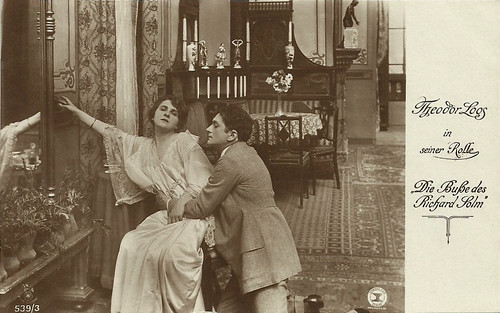
German postcard in the Film-Sterne series by Rotophot, no. 539/3. Photo: Amboß-Film Dworsky & Co., Berlin. Lia Borré and Theodor Loos in Die Buße des Richard Solm/The Penance of Richard Solm (Arthur Wellin, 1918).
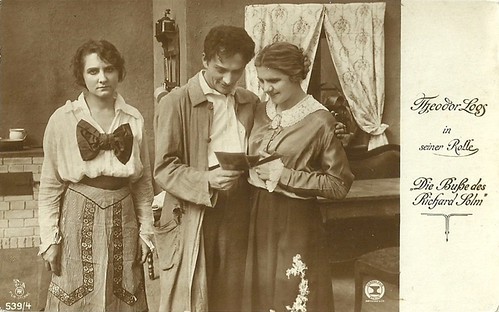
German postcard in the Film-Sterne series by Rotophot, no. 539/4. Photo: Amboß-Film Dworsky & Co., Berlin. Theodor Loos in Die Buße des Richard Solm/The Penance of Richard Solm (Arthur Wellin, 1918). The woman on the left is Lia Borré, the one on the right is Else Kühne.
Getrennte Welten (1918)
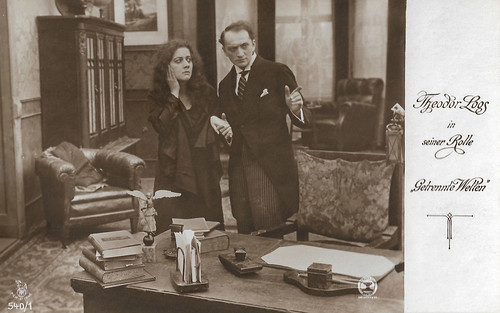
German postcard in the Film-Sterne series by Rotophot, no. 540/1. Photo: Amboß-Film - Dworsky Co. Theodor Loos and an unknown woman in Getrennte Welten/Separated Worlds (Arthur Wellin, 1918). It was Amboss's seventh film.
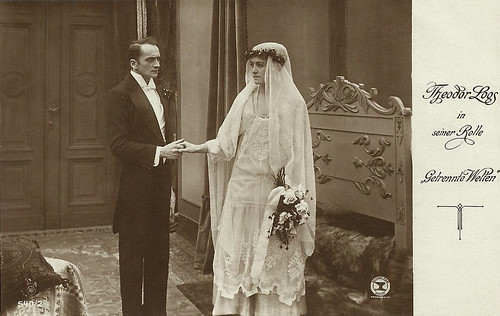
German postcard in the Film-Sterne series by Rotophot, no. 540/2. Photo: Amboß-Film - Dworsky Co. Theodor Loos and Gertrud Beitz in Getrennte Welten/Separated Worlds (Arthur Wellin, 1918).
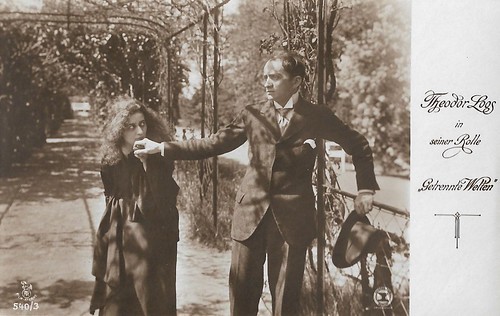
German postcard in the Film-Sterne series by Rotophot, no. 540/3. Photo: Amboß-Film - Dworsky Co. Theodor Loos and Gertrud Beitz in Getrennte Welten/Separated Worlds (Arthur Wellin, 1918).
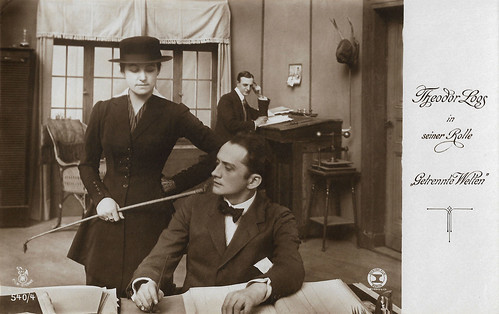
German postcard in the Film-Sterne series by Rotophot, no. 540/4. Photo: Amboß-Film - Dworsky Co. Theodor Loos and Gertrud Beitz in Getrennte Welten/Separated Worlds (Arthur Wellin, 1918).
Sources: Wikipedia and IMDb.
Die singende Hand (1918)

German postcard in the Film-Sterne series by Rotophot, no. 530/1. Photo: Amboß-Film Dworsky & Co., Berlin. Theodor Loos as the violin player Leonid Heller in Die singende Hand/The Singing Hand (Arthur Wellin, 1918). The woman is Eva Speyer.

German postcard in the Film-Sterne series by Rotophot, no. 530/2. Photo: Amboß-Film Dworsky & Co., Berlin. Theodor Loos in Die singende Hand/The Singing Hand (Arthur Wellin, 1918).

German postcard in the Film-Sterne series by Rotophot, no. 530/3. Photo: Amboß-Film Dworsky & Co., Berlin. Theodor Loos in Die singende Hand/The Singing Hand (Arthur Wellin, 1918). The woman on the ground is Eva Speyer as Esther. The man left of Loos is Otto Gebühr , playing the Duke of Gralby.

German postcard in the Film-Sterne series by Rotophot, no. 530/4. Photo: Amboß-Film Dworsky & Co., Berlin. Theodor Loos in Die singende Hand/The Singing Hand (Arthur Wellin, 1918). The woman is Eva Speyer.
Who were Hugo Landsberger and Arthur Wellin?
Die Singende Hand/The Singing Hand (Arthur Wellin, 1918) was scripted by Hans Land, the pseudonym of Hugo Landsberger. Some sources erroneously mention the film was based on a novel by Hans Lau, but it was Landsberger who in hindsight in 1926 published his script as a novel, edited by Oestergaard. The producer, Rudolf Dworsky, was also responsible for the set design.
Hugo Landsberger (1861-reported missing 1938) was a Jewish writer, who produced several socially engaged short stories, books, and plays under the pseudonym of Hans Land, while he also produced popular entertainment works such as 'Stürme' (1909) and 'Staatsanwalt Jordan' (1915). From 1913 he also wrote various film scripts. Land also acted occasionally and directed the film Stürme (1913), based on his own work.
Arthur Wellin (1880-prob. 1941) was a Jewish film director, originally Arthur Lewin. He had been a prolific stage director before shifting to film, the reason for Austrian actor Alexander Moissi to engage him as a film director for 5 films between 1918 and 1920.
Wellin was also co-owner of Ambross-Film, with Dworsky. All in all, he directed some 27 silent films, and at times also acted. In 1933 he was expelled from acting when Hitler took over in Germany. In 1941 he was deported from Prague to the Lodz ghetto in Poland, and from there probably sent to one of the extermination camps.
The film Die Singende Hand/The Singing Hand (Arthur Wellin, 1918) premiered in Berlin in May 1918.
Die Buße des Richard Solm (1918)

German postcard in the Film-Sterne series by Rotophot, no. 539/2. Photo: Amboß-Film Dworsky & Co., Berlin. Theodor Loos in Die Buße des Richard Solm/The Penance of Richard Solm (Arthur Wellin, 1918).

German postcard in the Film-Sterne series by Rotophot, no. 539/3. Photo: Amboß-Film Dworsky & Co., Berlin. Lia Borré and Theodor Loos in Die Buße des Richard Solm/The Penance of Richard Solm (Arthur Wellin, 1918).

German postcard in the Film-Sterne series by Rotophot, no. 539/4. Photo: Amboß-Film Dworsky & Co., Berlin. Theodor Loos in Die Buße des Richard Solm/The Penance of Richard Solm (Arthur Wellin, 1918). The woman on the left is Lia Borré, the one on the right is Else Kühne.
Getrennte Welten (1918)

German postcard in the Film-Sterne series by Rotophot, no. 540/1. Photo: Amboß-Film - Dworsky Co. Theodor Loos and an unknown woman in Getrennte Welten/Separated Worlds (Arthur Wellin, 1918). It was Amboss's seventh film.

German postcard in the Film-Sterne series by Rotophot, no. 540/2. Photo: Amboß-Film - Dworsky Co. Theodor Loos and Gertrud Beitz in Getrennte Welten/Separated Worlds (Arthur Wellin, 1918).

German postcard in the Film-Sterne series by Rotophot, no. 540/3. Photo: Amboß-Film - Dworsky Co. Theodor Loos and Gertrud Beitz in Getrennte Welten/Separated Worlds (Arthur Wellin, 1918).

German postcard in the Film-Sterne series by Rotophot, no. 540/4. Photo: Amboß-Film - Dworsky Co. Theodor Loos and Gertrud Beitz in Getrennte Welten/Separated Worlds (Arthur Wellin, 1918).
Sources: Wikipedia and IMDb.
Published on August 14, 2021 22:00
August 13, 2021
Turismofoto
Turismofoto is one of the lesser-known Italian editors of 'cartoline'. During the late 1950s, Turismofoto produced more than 100 black & white postcards of Italian film stars and entertainers, with a few cards of Hollywood and French stars included.
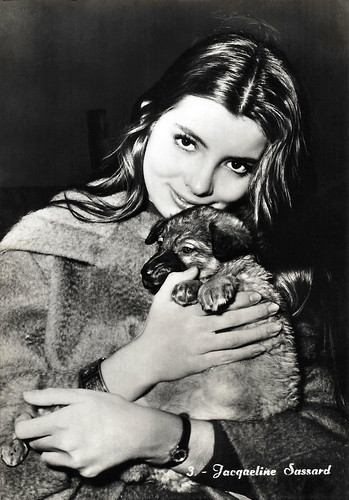
Italian postcard by Turismofoto, no. 3.
Charming and beautiful Jacqueline Sassard (1940-2021) had a short but successful career in the European cinema of the late 1950s and 1960s.
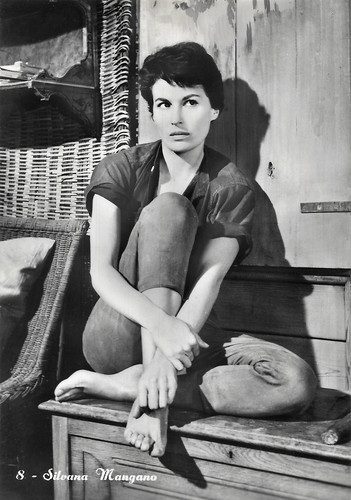
Italian postcard by Turismofoto, no. 8. Silvana Mangano in This Angry Age (René Clément, 1957).
Beautiful Italian film star Silvana Mangano (1930-1989) will be remembered most for the sexy rice picker in Riso Amaro/Bitter Rice (1949), and for Tadzio's elegant mother in Morte a Venezia/Death in Venice (1971).
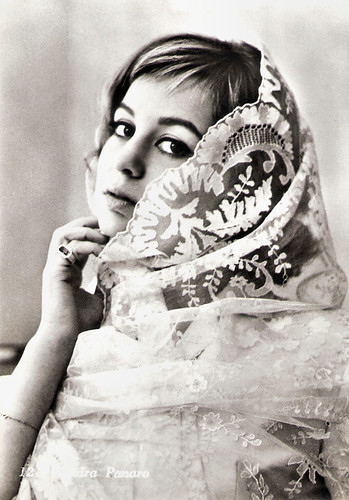
Italian postcard by Turismofoto, no. 12.
Alessandra Panaro (1939-29019) was an Italian film actress of the late 1950s and early 1960s. She is best known for Luchino Visconti's crime drama Rocco e i suoi fratelli/Rocco and His Brothers (1960).
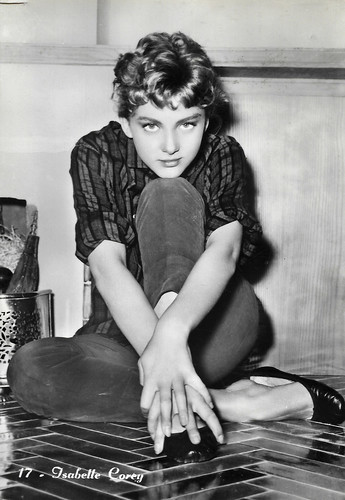
Italian postcard by Turismofoto, no. 17. Sent by mail in 1958.
French film actress Isabelle Corey (1939-2011) appeared in French and Italian films in the 1950s and early 1960s. Her best film was her first, the Film Noir Bob le flambeur/Bob the Gambler (Jean-Pierre Melville, 1956).
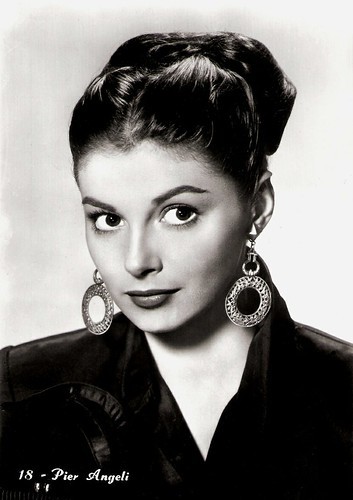
Italian postcard by Turismofoto, no. 18.
Before she was 20, Pier Angeli (1932-1971) had starred with Vittorio de Sica in two Italian box office hits and was discovered by Hollywood. There she won a Golden Globe, had an affair with James Dean, and died before she was 40.
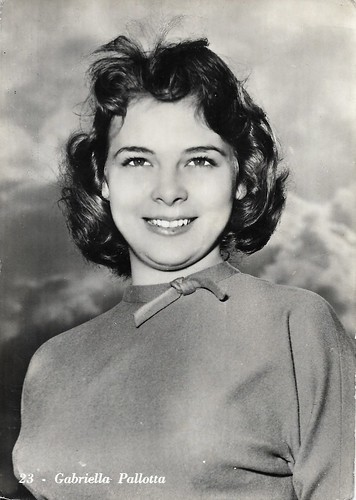
Italian postcard by Turismofoto, no. 23.
Gabriella Pallotta (1938) was an Italian film and TV actress between the mid-1950s and mid-1970s. She had her breakthrough with the drama Il tetto (Vittorio De Sica, 1956), for which she was selected by De Sica after screentests. The release of the film provided her with instant success and she immediately got supporting parts in films by Michelangelo Antonioni (Il grido) and Mario Moncelli (Il medico e lo stregone), both from 1957.
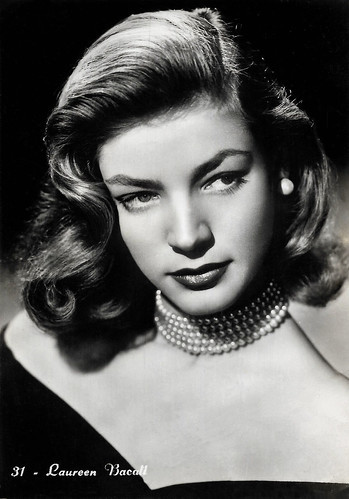
Italian postcard by Turismofoto, no. 31.
At 19, American film actress Lauren Bacall (1924–2014) became an overnight star as 'Slim' opposite Humphrey Bogart in her memorable film debut in To Have and Have Not (Howard Hawks, 1942). She became known for her distinctive husky voice and glamorous looks in Film Noirs as The Big Sleep (Howard Hawks, 1946), Dark Passage (Delmer Daves, 1947), and Key Largo (John Huston, 1948), and the delicious comedy How to Marry a Millionaire (Jean Negulesco, 1953) with Marilyn Monroe. After a 50-year career, she received a Golden Globe and her first Oscar nomination for supporting actress for her role as Barbra Streisand’s mother in The Mirror Has Two Faces (Barbra Streisand, 1997).
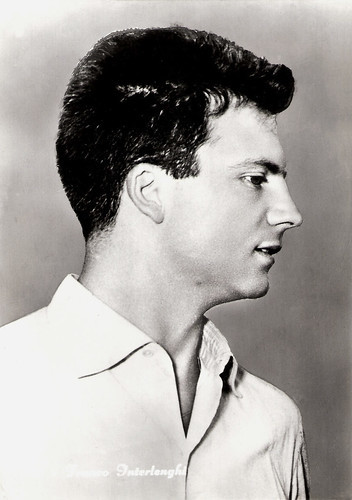
Italian postcard by Turismofoto.
Italian actor Franco Interlenghi (1931-2015) was a popular leading man during the 1950s and worked with major directors like De Sica, Fellini, Antonioni, Bolognini, and Rossellini. Although he never gained international stardom, he was just as revered in his country as Marcello Mastroianni.
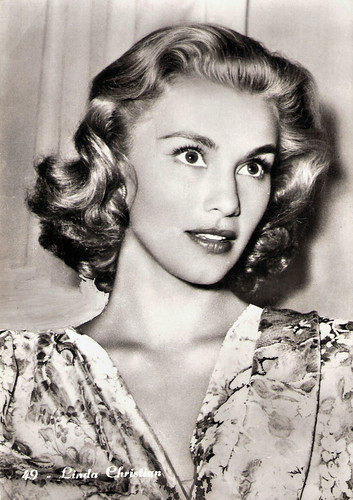
Italian postcard by Turismofoto, no. 49.
Linda Christian (1923-2011) was the first Bond girl ever. This sensuous, incredibly beautiful starlet appeared in dozens of films in Mexico, Hollywood, and Europe. She starred with Johnny Weissmuller in his last Tarzan film, Tarzan and The Mermaids (1948), but she became most famous as Mrs. Tyrone Power.
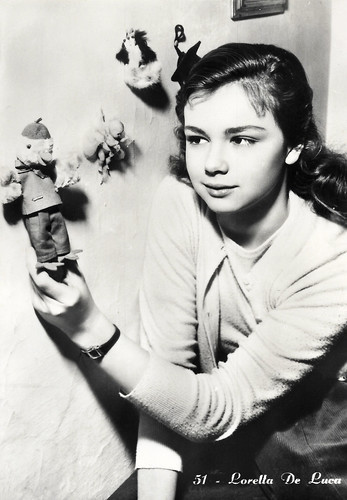
Italian postcard by Turismofoto, no. 51.
After her 'discovery' at the age of 14, Italian actress Lorella De Luca (1940-2014) became the Sandra Dee of the Italian cinema of the 1950s. Her fresh and graceful appearance in hit comedies like Poveri ma belli/Poor But Beautiful (1956) endeared her to the public. De Luca was the widow of film director Duccio Tessari, in whose films she often starred.
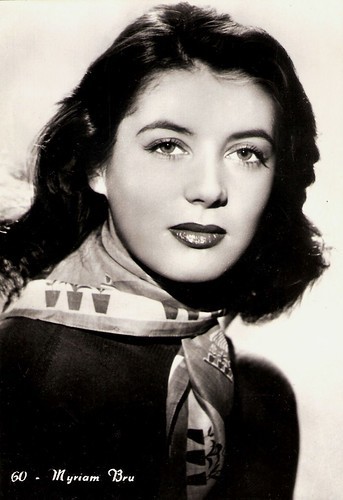
Italian postcard by Turismofoto, no. 60.
French actress Myriam Bru (1932) appeared in some 15 European film productions of the 1950s. She was the wife of Horst Buchholz.
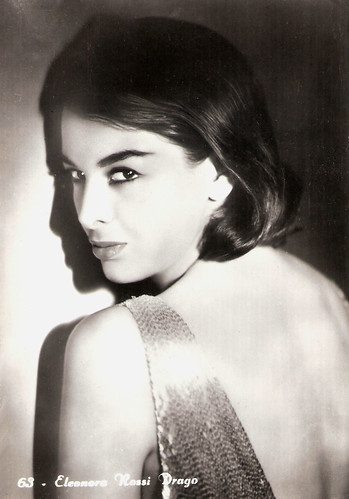
Italian postcard by Turismofoto, no. 63.
Voluptuous, visually stunning Italian film actress Eleonora Rossi Drago (1925–2007) played princesses and temptresses throughout Italian cinema of the 1950s and 1960s. She never found the international cross-over fame destined for Sophia Loren and Gina Lollobrigida, but she earned respect as a fine actress playing leading roles in films by famous directors like Michelangelo Antonioni, Luigi Comencini, and Valerio Zurlini.
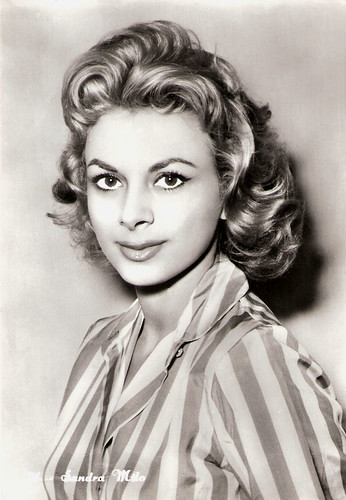
Italian postcard by Turismofoto, no. 71.
Italian actress Sandra Milo (1933) is best known for her roles in Federico Fellini's 8½ (1963) and Giulietta degli spiriti/Juliet of the Spirits (1965), but also worked with the famous directors Antonio Pietrangeli and Roberto Rossellini. She won a Silver Ribbon for best supporting actress award for both 8½ and Juliet of the Spirits.
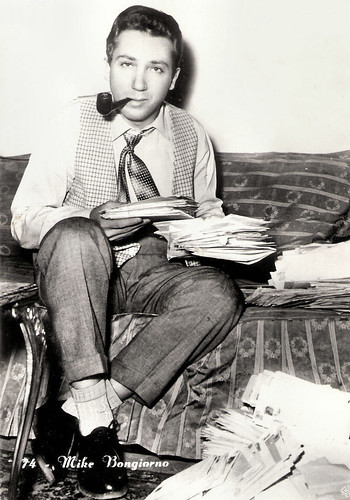
Italian postcard by Turismofoto, no. 74.
Mike Bongiorno (1924-2009) was an Italo-American journalist and television host. For the history of Italian television, he has been an institution as Italy’s famous quiz master between the 1950s to the 1980s. As such he played himself in various films too.
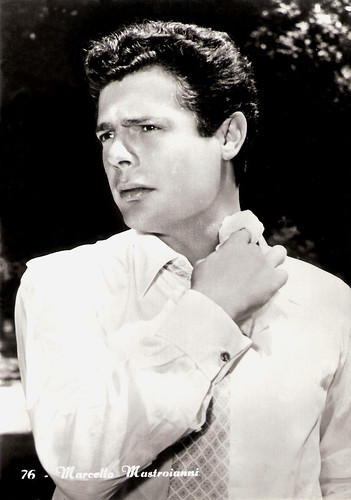
Italian postcard by Turismofoto, no. 76.
Film actor Marcello Mastroianni (1924-1996) was Italy's favorite leading man since the 1950s, as well as one of the finest actors of European cinema. In his long and prolific career, Mastroianni almost singlehandedly defined the contemporary type of Latin lover, then proceeded to redefine it a dozen times and finally parodied it and played it against type.
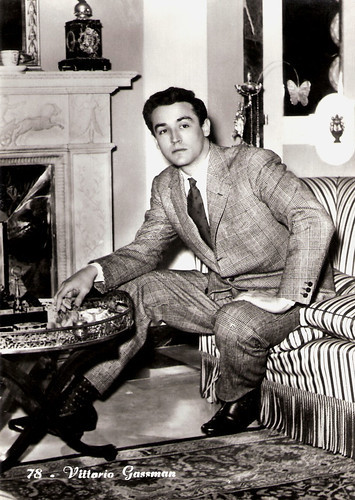
Italian postcard by Turismofoto, no. 78.
Handsome, flamboyant Vittorio Gassman (1922-2000) was one of the greatest Italian theatre and film actors with an extraordinary career that spanned five decades. With his powerful voice, he was an extremely versatile, magnetic interpreter, whose long career included both highlights of the 'Commedia all Italiana' genre as well as powerful melodramas in which he played the beloved rogue.
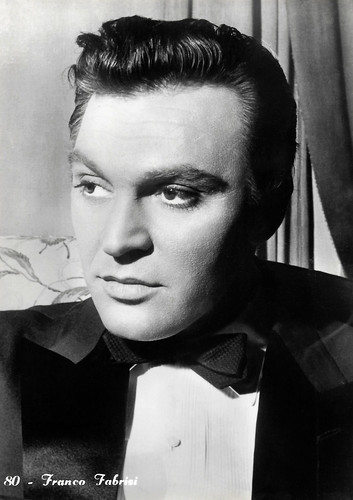
Italian postcard by Turismofoto, no. 80.
Italian actor Franco Fabrizi (1926–1995) played in about 150 films, usually as the superficial opportunistic sidekick. He made his film debut under Michelangelo Antonioni and became known as a cynical but charming womanizer in Federico Fellini’s I Vitelloni (1953). In later life, he appeared in Luchino Visconti's Death in Venice (1971) and Fellini’s Ginger and Fred (1986).
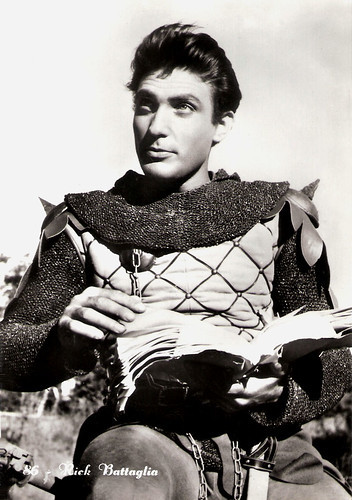
Italian postcard by Turismofoto, no. 86.
Italian film actor Rik Battaglia (1927-2015) made nearly 100 film appearances between 1954 and 1999. He played the bad guy in dozens of Peplums, Eurowesterns, and war films. In Germany, he became notorious as ‘The Man Who Shot Winnetou.'
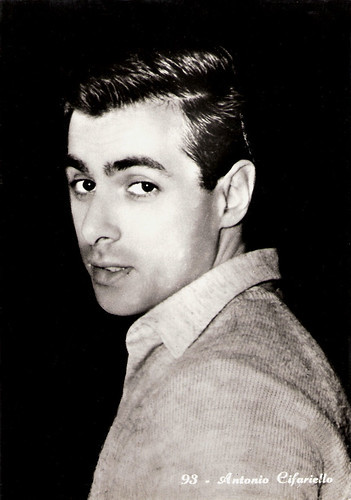
Italian postcard by Turismofoto, no. 93.
Handsome Antonio Cifariello (1930–1968) was an Italian actor and documentary filmmaker. In his short but intense career, he starred in several Italian comedies as a young and seductive Don Giovanni. He worked with several famous directors, including Federico Fellini, Dino Risi, Luigi Comencini, and Valerio Zurlini. Cifariello also appeared in a few international films.
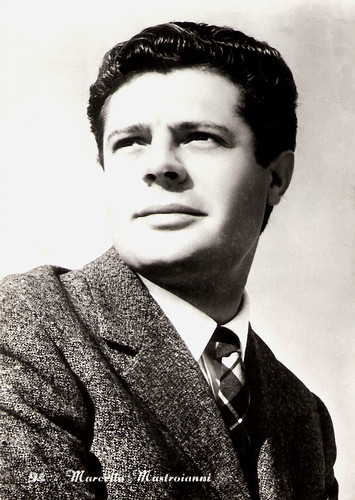
Italian postcard by Turismofoto, no. 94.
Film actor Marcello Mastroianni (1924-1996) was Italy's favorite leading man since the 1950s, as well as one of the finest actors of European cinema. In his long and prolific career, Mastroianni almost singlehandedly defined the contemporary type of Latin lover, then proceeded to redefine it a dozen times and finally parodied it and played it against type.
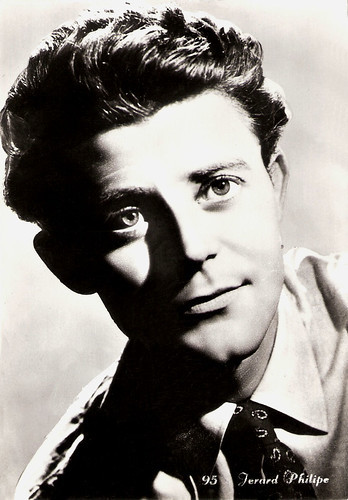
Italian postcard by Turismofoto, no. 95.
The legendary idol of the French cinema, Gérard Philipe (1922–1959) was adored for his good looks, but he was also a very talented actor. He played roles as diverse as Faust and Modigliani and he was sought out by France's preeminent directors for his versatility and professionalism.
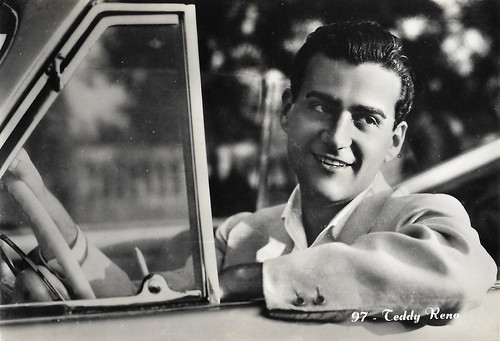
Italian postcard by Turismofoto, Milano, no. 97.
Teddy Reno (1926), is an Italian singer, record producer, and actor, and naturalized Swiss.
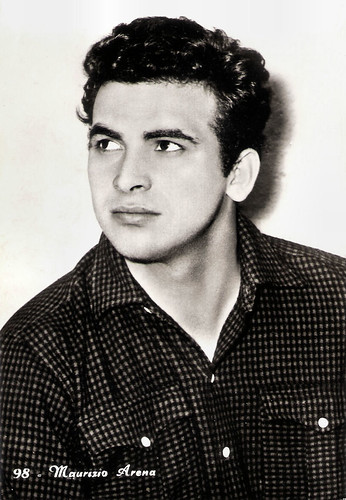
Italian postcard by Turismofoto, no. 98.
Italian film actor Maurizio Arena (1933-1979) appeared in 78 films between 1952 and 1978. In the late 1950s, he became popular as the poor but handsome Roman working-class boy in a comedy trilogy by Dino Risi.
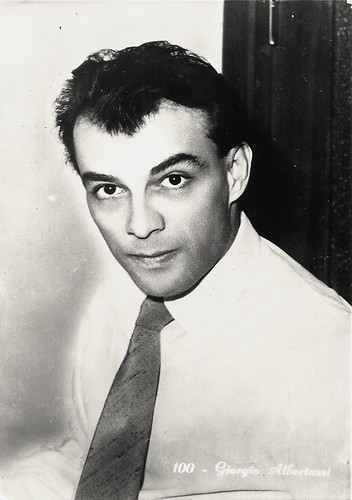
Italian postcard. Turismofoto, no. 100.
Giorgio Albertazzi (1923-2016) was an Italian actor and theatre director. An active theatre actor for decades, he was also one of the first television stars.
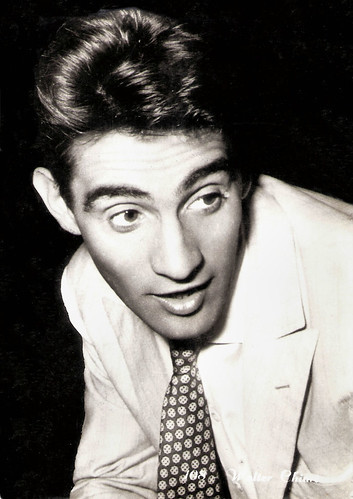
Italian postcard by Turismofoto, no. 108
Good-looking Walter Chiari (1924-1991) was a hugely successful Italian stage and screen actor. He appeared opposite Anna Magnani in Luchino Visconti's Bellissima (1951) and played countless roles in the Commedia all'italiana. Chiari achieved international success with The Little Hut (1957), Bonjour Tristesse (1958), Chimes at Midnight (1966), and The Valachi Papers (1972). In the late 1950s and 1960s, he was one of the main protagonists of the ‘Dolce Vita’, the glitzy and glamorous Italian jet-set scene, but a drug scandal in 1970 hurt his screen career.
See also our Turismofoto album at Flickr.

Italian postcard by Turismofoto, no. 3.
Charming and beautiful Jacqueline Sassard (1940-2021) had a short but successful career in the European cinema of the late 1950s and 1960s.

Italian postcard by Turismofoto, no. 8. Silvana Mangano in This Angry Age (René Clément, 1957).
Beautiful Italian film star Silvana Mangano (1930-1989) will be remembered most for the sexy rice picker in Riso Amaro/Bitter Rice (1949), and for Tadzio's elegant mother in Morte a Venezia/Death in Venice (1971).

Italian postcard by Turismofoto, no. 12.
Alessandra Panaro (1939-29019) was an Italian film actress of the late 1950s and early 1960s. She is best known for Luchino Visconti's crime drama Rocco e i suoi fratelli/Rocco and His Brothers (1960).

Italian postcard by Turismofoto, no. 17. Sent by mail in 1958.
French film actress Isabelle Corey (1939-2011) appeared in French and Italian films in the 1950s and early 1960s. Her best film was her first, the Film Noir Bob le flambeur/Bob the Gambler (Jean-Pierre Melville, 1956).

Italian postcard by Turismofoto, no. 18.
Before she was 20, Pier Angeli (1932-1971) had starred with Vittorio de Sica in two Italian box office hits and was discovered by Hollywood. There she won a Golden Globe, had an affair with James Dean, and died before she was 40.

Italian postcard by Turismofoto, no. 23.
Gabriella Pallotta (1938) was an Italian film and TV actress between the mid-1950s and mid-1970s. She had her breakthrough with the drama Il tetto (Vittorio De Sica, 1956), for which she was selected by De Sica after screentests. The release of the film provided her with instant success and she immediately got supporting parts in films by Michelangelo Antonioni (Il grido) and Mario Moncelli (Il medico e lo stregone), both from 1957.

Italian postcard by Turismofoto, no. 31.
At 19, American film actress Lauren Bacall (1924–2014) became an overnight star as 'Slim' opposite Humphrey Bogart in her memorable film debut in To Have and Have Not (Howard Hawks, 1942). She became known for her distinctive husky voice and glamorous looks in Film Noirs as The Big Sleep (Howard Hawks, 1946), Dark Passage (Delmer Daves, 1947), and Key Largo (John Huston, 1948), and the delicious comedy How to Marry a Millionaire (Jean Negulesco, 1953) with Marilyn Monroe. After a 50-year career, she received a Golden Globe and her first Oscar nomination for supporting actress for her role as Barbra Streisand’s mother in The Mirror Has Two Faces (Barbra Streisand, 1997).

Italian postcard by Turismofoto.
Italian actor Franco Interlenghi (1931-2015) was a popular leading man during the 1950s and worked with major directors like De Sica, Fellini, Antonioni, Bolognini, and Rossellini. Although he never gained international stardom, he was just as revered in his country as Marcello Mastroianni.

Italian postcard by Turismofoto, no. 49.
Linda Christian (1923-2011) was the first Bond girl ever. This sensuous, incredibly beautiful starlet appeared in dozens of films in Mexico, Hollywood, and Europe. She starred with Johnny Weissmuller in his last Tarzan film, Tarzan and The Mermaids (1948), but she became most famous as Mrs. Tyrone Power.

Italian postcard by Turismofoto, no. 51.
After her 'discovery' at the age of 14, Italian actress Lorella De Luca (1940-2014) became the Sandra Dee of the Italian cinema of the 1950s. Her fresh and graceful appearance in hit comedies like Poveri ma belli/Poor But Beautiful (1956) endeared her to the public. De Luca was the widow of film director Duccio Tessari, in whose films she often starred.

Italian postcard by Turismofoto, no. 60.
French actress Myriam Bru (1932) appeared in some 15 European film productions of the 1950s. She was the wife of Horst Buchholz.

Italian postcard by Turismofoto, no. 63.
Voluptuous, visually stunning Italian film actress Eleonora Rossi Drago (1925–2007) played princesses and temptresses throughout Italian cinema of the 1950s and 1960s. She never found the international cross-over fame destined for Sophia Loren and Gina Lollobrigida, but she earned respect as a fine actress playing leading roles in films by famous directors like Michelangelo Antonioni, Luigi Comencini, and Valerio Zurlini.

Italian postcard by Turismofoto, no. 71.
Italian actress Sandra Milo (1933) is best known for her roles in Federico Fellini's 8½ (1963) and Giulietta degli spiriti/Juliet of the Spirits (1965), but also worked with the famous directors Antonio Pietrangeli and Roberto Rossellini. She won a Silver Ribbon for best supporting actress award for both 8½ and Juliet of the Spirits.

Italian postcard by Turismofoto, no. 74.
Mike Bongiorno (1924-2009) was an Italo-American journalist and television host. For the history of Italian television, he has been an institution as Italy’s famous quiz master between the 1950s to the 1980s. As such he played himself in various films too.

Italian postcard by Turismofoto, no. 76.
Film actor Marcello Mastroianni (1924-1996) was Italy's favorite leading man since the 1950s, as well as one of the finest actors of European cinema. In his long and prolific career, Mastroianni almost singlehandedly defined the contemporary type of Latin lover, then proceeded to redefine it a dozen times and finally parodied it and played it against type.

Italian postcard by Turismofoto, no. 78.
Handsome, flamboyant Vittorio Gassman (1922-2000) was one of the greatest Italian theatre and film actors with an extraordinary career that spanned five decades. With his powerful voice, he was an extremely versatile, magnetic interpreter, whose long career included both highlights of the 'Commedia all Italiana' genre as well as powerful melodramas in which he played the beloved rogue.

Italian postcard by Turismofoto, no. 80.
Italian actor Franco Fabrizi (1926–1995) played in about 150 films, usually as the superficial opportunistic sidekick. He made his film debut under Michelangelo Antonioni and became known as a cynical but charming womanizer in Federico Fellini’s I Vitelloni (1953). In later life, he appeared in Luchino Visconti's Death in Venice (1971) and Fellini’s Ginger and Fred (1986).

Italian postcard by Turismofoto, no. 86.
Italian film actor Rik Battaglia (1927-2015) made nearly 100 film appearances between 1954 and 1999. He played the bad guy in dozens of Peplums, Eurowesterns, and war films. In Germany, he became notorious as ‘The Man Who Shot Winnetou.'

Italian postcard by Turismofoto, no. 93.
Handsome Antonio Cifariello (1930–1968) was an Italian actor and documentary filmmaker. In his short but intense career, he starred in several Italian comedies as a young and seductive Don Giovanni. He worked with several famous directors, including Federico Fellini, Dino Risi, Luigi Comencini, and Valerio Zurlini. Cifariello also appeared in a few international films.

Italian postcard by Turismofoto, no. 94.
Film actor Marcello Mastroianni (1924-1996) was Italy's favorite leading man since the 1950s, as well as one of the finest actors of European cinema. In his long and prolific career, Mastroianni almost singlehandedly defined the contemporary type of Latin lover, then proceeded to redefine it a dozen times and finally parodied it and played it against type.

Italian postcard by Turismofoto, no. 95.
The legendary idol of the French cinema, Gérard Philipe (1922–1959) was adored for his good looks, but he was also a very talented actor. He played roles as diverse as Faust and Modigliani and he was sought out by France's preeminent directors for his versatility and professionalism.

Italian postcard by Turismofoto, Milano, no. 97.
Teddy Reno (1926), is an Italian singer, record producer, and actor, and naturalized Swiss.

Italian postcard by Turismofoto, no. 98.
Italian film actor Maurizio Arena (1933-1979) appeared in 78 films between 1952 and 1978. In the late 1950s, he became popular as the poor but handsome Roman working-class boy in a comedy trilogy by Dino Risi.

Italian postcard. Turismofoto, no. 100.
Giorgio Albertazzi (1923-2016) was an Italian actor and theatre director. An active theatre actor for decades, he was also one of the first television stars.

Italian postcard by Turismofoto, no. 108
Good-looking Walter Chiari (1924-1991) was a hugely successful Italian stage and screen actor. He appeared opposite Anna Magnani in Luchino Visconti's Bellissima (1951) and played countless roles in the Commedia all'italiana. Chiari achieved international success with The Little Hut (1957), Bonjour Tristesse (1958), Chimes at Midnight (1966), and The Valachi Papers (1972). In the late 1950s and 1960s, he was one of the main protagonists of the ‘Dolce Vita’, the glitzy and glamorous Italian jet-set scene, but a drug scandal in 1970 hurt his screen career.
See also our Turismofoto album at Flickr.
Published on August 13, 2021 22:00
August 12, 2021
John Travolta
John Travolta (1954) is an American actor and singer, who rose to fame during the 1970s, when he appeared on the television sitcom Welcome Back, Kotter (1975-1979), and starred in the box office successes Carrie (1976), Saturday Night Fever (1977), Grease (1978) and Urban Cowboy (1980). His acting career declined throughout the 1980s, but in 1994, Travolta made one of the most stunning comebacks in entertainment history by starring in Quentin Tarantino's Pulp Fiction (1994). Since then he starred in such films as Get Shorty (1995), Face/Off (1997), Primary Colors (1998), and Hairspray (2007). Travolta was nominated for the Academy Award for Best Actor for performances in Saturday Night Fever and Pulp Fiction. In 2016, he received his first Primetime Emmy Award, as a producer of the anthology series American Crime Story in which he also played lawyer Robert Shapiro.
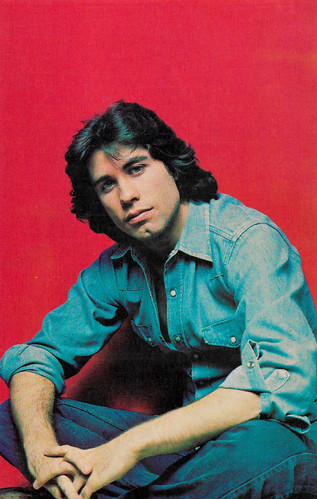
American postcard by Coral-Lee, Rancho Cordova, CA, no. CL/Personality #12. Photo: Douglas Kirkland / Contact, 1977.

German promotion card by Polydor, no. 118. John Travolta in Grease (Randal Kleiser, 1978).

Romanian postcard by Casa Filmului Acin, no. C.P.C.S. 33 150. John Travolta in Staying Alive (Sylvester Stallone, 1983).
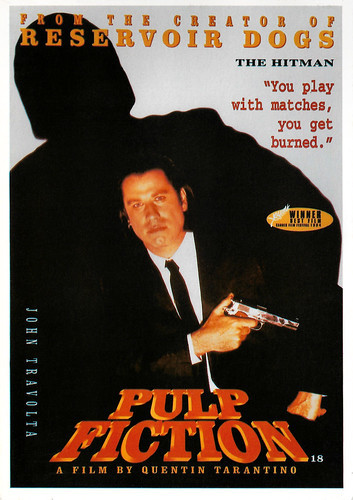
British postcard, no. C077. John Travolta in Pulp Fiction (Quentin Tarantino, 1994). The Hitman: "You play with matches, you get burned."
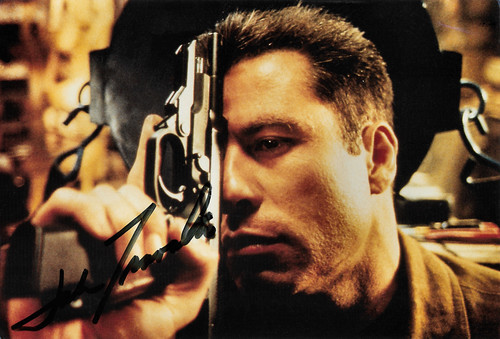
Vintage autograph photo. John Travolta in Broken Arrow (John Woo, 1996).
A latter-day Rebel Without a Cause in the New York City disco nightlife
The youngest of six children, John Travolta was born in 1954 in Englewood, New Jersey, an inner-ring suburb of New York City in Bergen County, New Jersey. His father, Salvatore "Sam" Travolta was a semiprofessional American football player turned tire salesman and partner in a tire company. His mother, Helen Travolta (née Helen Cecilia Burke) was an actress and singer who had appeared in The Sunshine Sisters, a radio vocal group, and acted and directed before becoming a high school drama and English teacher. His siblings Joey, Ellen, Ann, Margaret, and Sam Travolta were all inspired by their mother's love of theatre and drama and became actors.
He was raised Roman Catholic but converted to Scientology in 1975. Travolta attended Dwight Morrow High School. By the age of 12, Travolta himself had already joined an area actors' group and soon began appearing in local musicals and dinner-theater performances. He started acting appearing in a local production of 'Who'll Save the Plowboy?'. At 16 he landed his first professional job in a summer stock production of the musical 'Bye Bye Birdie'.
In 1971, he dropped out of school at age 17 and moved across the Hudson River to New York City. He made his off-Broadway debut in 1972 in 'Rain' and then landed a small role in the touring company of the hit musical 'Grease'. Then followed on Broadway 'Over Here!', starring The Andrews Sisters, in which he sang the Sherman Brothers' song 'Dream Drummin''.
He then moved to Los Angeles to try Hollywood. Travolta's first screen role in California was as a fall victim in the television series Emergency!, in September 1972, but his first significant film role was as Billy Nolan, a bully who was goaded into playing a prank on Sissy Spacek's character in the horror film Carrie (Brian De Palma, 1976), the first film adaptation of a Stephen King novel.
Around the same time, he landed the role as Vinnie Barbarino in the ABC TV sitcom Welcome Back, Kotter (1975–1979), in which his sister, Ellen, also occasionally appeared as Arnold Horshack's mother. He shot to overnight superstardom, and his face instantly adorned T-shirts and lunch boxes. Travolta had a hit single titled 'Let Her In', peaking at number 10 on the Billboard Hot 100 chart in July 1976. That year, he starred in the TV movie The Boy in the Plastic Bubble (Randal Kleiser, 1976).
Then followed the first of his two most noted screen roles: Tony Manero in Saturday Night Fever (John Badham, 1977). Jason Ankeny at AllMovie : "A latter-day Rebel Without a Cause set against the backdrop of the New York City disco nightlife, it positioned Travolta as the most talked-about young star in Hollywood. In addition to earning his first Academy Award nomination for Best Actor, he also became an icon of the era, his white-suited visage and cocky, rhythmic strut enduring as defining images of late-'70s American culture."
He followed it up with the part of Danny Zuko in the film adaptation of Grease (Randal Kleiser, 1978) with Olivia Newton-John. Its box-office success was even greater than Saturday Night Fever's. Both films were among the most commercially successful pictures of the decade and catapulted Travolta to international stardom. Saturday Night Fever earned him an Academy Award nomination for Best Actor, making him, at age 24, one of the youngest performers ever nominated for the Best Actor Oscar. Travolta performed several of the songs on the Grease soundtrack album.
After the laughable May-December romance Moment by Moment (Jane Wagner, 1978) in which he starred with Lily Tomlin, Travolta, in 1980, inspired a nationwide country music craze that followed on the heels of his hit film Urban Cowboy (James Bridges, 1980), in which he starred with Debra Winger. Another success was the thriller Blow Out (Brian De Palma, 1981) with Nancy Allen.
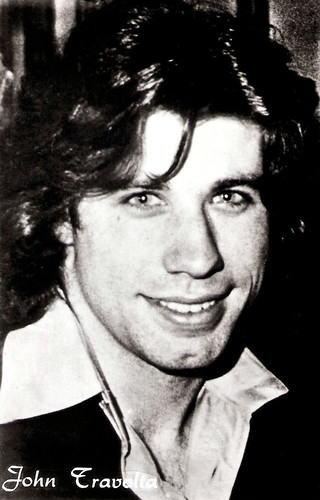
Dutch postcard, no. AX 7380.

Dutch postcard, no. AX 7377. John Travolta and Olivia Newton-John in Grease (Randal Kleiser, 1978).

Dutch postcard, no. AX 7381. John Travolta in Grease (Randal Kleiser, 1978).

Dutch postcard, no. AX 7377. John Travolta and Olivia Newton-John in Grease (Randal Kleiser, 1978).
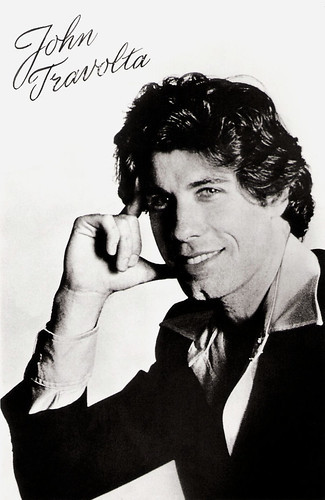
Dutch postcard, no. AX 7376.
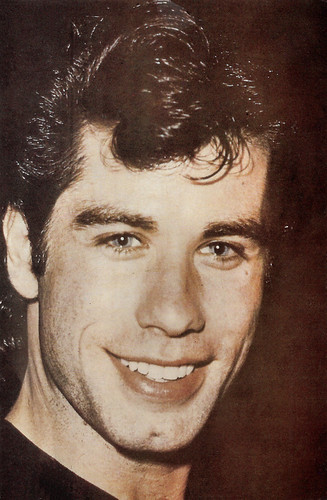
Dutch postcard, no. AG 1015. John Travolta in Grease (Randal Kleiser, 1978).
Travolta reportedly waived his salary to play the role
During the 1980s, John Travolta starred in a series of commercial and critical failures that sidelined his acting career. These included Two of a Kind (John Herzfeld, 1983), a romantic comedy reuniting him with Olivia Newton-John, and Perfect (James Bridges, 1985), co-starring Jamie Lee Curtis.
He also starred in Staying Alive (Sylvester Stallone, 1983), the sequel to Saturday Night Fever, for which he trained rigorously and lost 20 pounds. The film was a financial success, grossing over $65 million, though it, too, was scorned by critics.
During that time, Travolta was offered, but declined, lead roles in what would become box-office hits, including American Gigolo (Paul Schrader, 1980) and An Officer and a Gentleman (Taylor Hackford, 1982), both of which went to Richard Gere , as well as Splash (Ton Howard, 1984), which went to Tom Hanks.
In 1989, Travolta starred with Kirstie Alley in Look Who's Talking (Amy Heckerling, 1989), which grossed $297 million, making it his most successful film since Grease. He subsequently starred in Look Who's Talking Too (Amy Heckerling, 1990) and Look Who's Talking Now (Tom Ropelewski, 1993).
But it was not until he played Vincent Vega in Quentin Tarantino's hit Pulp Fiction (1994), with Samuel L. Jackson and Uma Thurman , for which he received an Academy Award nomination, that his career was revived. Quentin Tarantino, a longtime Travolta fan, wrote the role of Vincent Vega specifically with the actor in mind. Jason Ankeny at AllMovie : "Travolta reportedly waived his salary to play the role. A critical as well as commercial smash, Pulp Fiction introduced Travolta to a new generation of moviegoers, and suddenly he was again a major star who could command a massive salary, with a second Academy Award nomination to prove it."
Travolta was inundated with offers. He followed Pulp Fiction with the Elmore Leonard adaptation Get Shorty (Barry Sonnenfeld, 1995). His turn as Mafioso-turned-movie producer Chili Palmer is acclaimed by many critics as his finest performance to date. The film was another major hit. Then followed roles in White Man's Burden (Desmond Nakano, 1995), Broken Arrow (John Woo, 1996), and Face/Off (John Woo, 1997) with Nicolas Cage. He also played a charismatic, Bill Clinton-like U.S. President in Primary Colors (Mike Nichols, 1998) opposite Emma Thompson. The political satire was critically acclaimed but earned only $52 million from a $65 million budget.

Dutch postcard. John Travolta and Olivia Newton-John in Grease (Randal Kleiser, 1978).
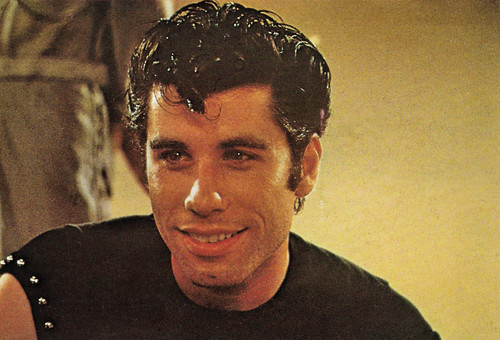
French postcard in the Collection John Travolta by Star, Paris. John Travolta in Grease (Randal Kleiser, 1978). Sent by mail in 1986.
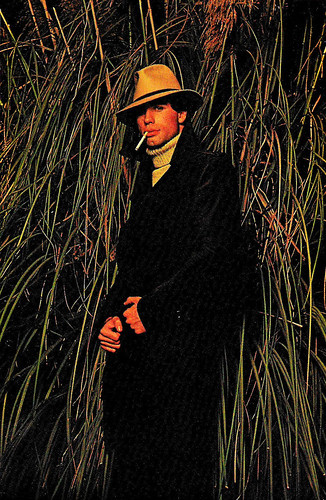
French postcard in the Collection John Travolta by Star, Paris. Caption: John Travolta, 1978. Sent by mail in 1985.
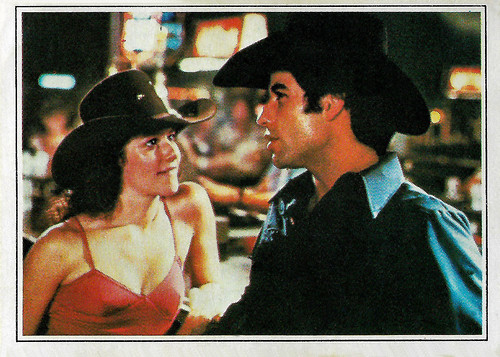
Spanish collectors card in the Cine Exitoso series by Ediciones Este, Barcelona, no. 230. Debra Winger and John Travolta in Urban Cowboy (James Bridges, 1980).
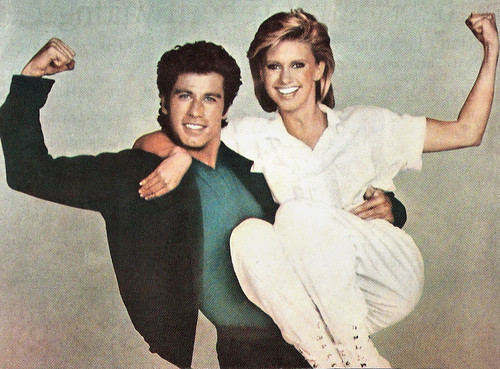
Romanian postcard by Casa Filmului Acin, no. 53190. John Travolta and Olivia Newton-John in Two of a Kind (John Herzfeld, 1983).
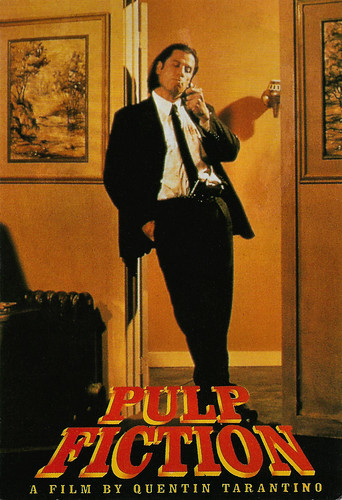
French postcard, no. C 583. John Travolta in Pulp Fiction (Quentin Tarantino, 1994).
A leader of a group of aliens that enslaves humanity
In 2000, John Travolta starred in and co-produced the science fiction film Battlefield Earth (Roger Christian, 2000), based on the novel of the same name by L. Ron Hubbard, in which he played the villainous leading role as a leader of a group of aliens that enslaves humanity on a bleak future Earth. The film had been a dream project for Travolta since the book's release in 1982 when Hubbard had written to him to try to help make a film adaptation. The film received almost universally negative reviews and did very poorly at the box office. Travolta's performance in Battlefield Earth also earned him two Razzie Awards.
Throughout the 2000s, Travolta remained busy as an actor, starring in many films, including Swordfish (Dominic Sena, 2001) with Hugh Jackman and Halle Berry, the crime-comedy Be Cool (F. Gary Gray, 2005) in which he again played ultra cool Chili Palmer, and the biker road comedy Wild Hogs (Walt Becker, 2007) starring Tim Allen.
In 2007, Travolta played Edna Turnblad in the remake of Hairspray (Adam Shankman, 2008), his first musical since Grease. In the Disney computer-animated film Bolt (Chris Williams, Byron Howard, 2008), Travolta voiced the title character. The next year, he appeared in the re-make of The Taking of Pelham 123 (Tony Scott, 2009) opposite Denzel Washington and in Old Dogs (Walt Decker, 2009) with Robin Williams.
Since 2010, Travolta has starred mostly in action films and thrillers. In 2016, he returned to television in the first season of the anthology series American Crime Story, titled The People v. O. J. Simpson, in which he played lawyer Robert Shapiro.
Travolta was in a relationship with actress Diana Hyland, 18 years his senior, whom he met while filming The Boy in the Plastic Bubble (1976). They remained together until Hyland's death from breast cancer in 1977. Travolta also had an on-again/off-again relationship with actress Marilu Henner, which ended permanently in 1985. He married actress Kelly Preston in 1991, and they bought a house in Islesboro, Maine. They had three children: Jett (1992–2009), Ella Bleu (2000), and Benjamin (2010).
In 2009, Jett died at age 16 while on a Christmas vacation in the Bahamas. A Bahamian death certificate was issued, attributing the cause of death to a seizure. Jett, who had a history of seizures, reportedly suffered from Kawasaki disease since the age of two. In 2020, Travolta's wife, Kelly Preston, died at the age of 57, two years after she had been diagnosed with breast cancer. Travolta has been a practitioner of Scientology since 1975. Following the death of his wife Kelly Preston in July 2020, Travolta hinted on his Instagram account that he would be putting his career on hold, stating "I will be taking some time to be there for my children who have lost their mother, so forgive me in advance if you don’t hear from us for a while."

Belgian postcard by Multichoice Kaleidoscope. Photo: Isopress / Outline (Bernstein).
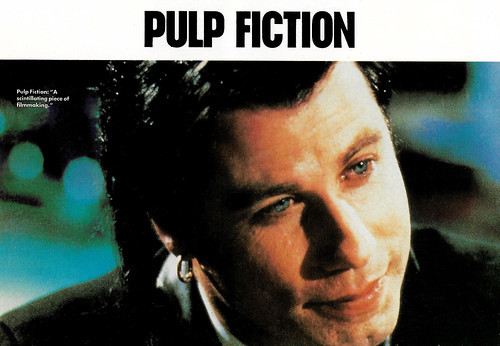
British postcard, no. MM 389. Photo: John Travolta in Pulp Fiction (Quentin Tarantino, 1994).
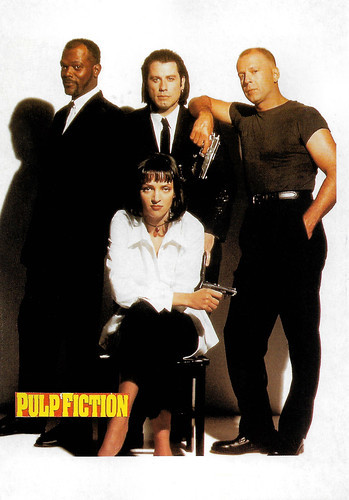
British postcard by Memory Card, no. 78. Samuel Jackson, John Travolta, Bruce Willis, and Uma Thurman in Pulp Fiction (Quentin Tarantino, 1994). Caption: lobby card.
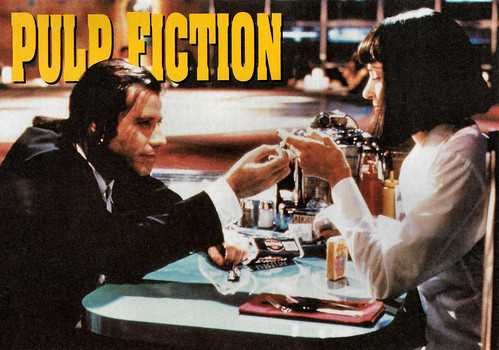
Vintage postcard, no. 2102. John Travolta and Uma Thurman in Pulp Fiction (Quentin Tarantino, 1994). Caption: John n Uma at table.
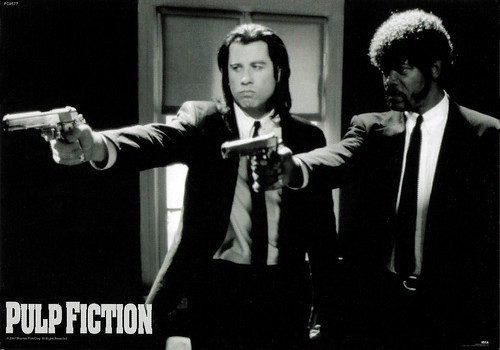
British postcard by Pyramid Posters, Leicester, no. PC9577. Photo: Miramax Film Corp. John Travolta and Samuel Jackson in Pulp Fiction (Quentin Tarantino, 1994). Caption: Guns B&W.
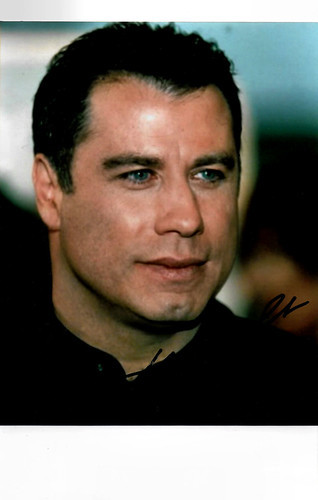
Vintage autograph card.
Sources: Jason Ankeny (AllMovie), Wikipedia and .

American postcard by Coral-Lee, Rancho Cordova, CA, no. CL/Personality #12. Photo: Douglas Kirkland / Contact, 1977.

German promotion card by Polydor, no. 118. John Travolta in Grease (Randal Kleiser, 1978).

Romanian postcard by Casa Filmului Acin, no. C.P.C.S. 33 150. John Travolta in Staying Alive (Sylvester Stallone, 1983).

British postcard, no. C077. John Travolta in Pulp Fiction (Quentin Tarantino, 1994). The Hitman: "You play with matches, you get burned."

Vintage autograph photo. John Travolta in Broken Arrow (John Woo, 1996).
A latter-day Rebel Without a Cause in the New York City disco nightlife
The youngest of six children, John Travolta was born in 1954 in Englewood, New Jersey, an inner-ring suburb of New York City in Bergen County, New Jersey. His father, Salvatore "Sam" Travolta was a semiprofessional American football player turned tire salesman and partner in a tire company. His mother, Helen Travolta (née Helen Cecilia Burke) was an actress and singer who had appeared in The Sunshine Sisters, a radio vocal group, and acted and directed before becoming a high school drama and English teacher. His siblings Joey, Ellen, Ann, Margaret, and Sam Travolta were all inspired by their mother's love of theatre and drama and became actors.
He was raised Roman Catholic but converted to Scientology in 1975. Travolta attended Dwight Morrow High School. By the age of 12, Travolta himself had already joined an area actors' group and soon began appearing in local musicals and dinner-theater performances. He started acting appearing in a local production of 'Who'll Save the Plowboy?'. At 16 he landed his first professional job in a summer stock production of the musical 'Bye Bye Birdie'.
In 1971, he dropped out of school at age 17 and moved across the Hudson River to New York City. He made his off-Broadway debut in 1972 in 'Rain' and then landed a small role in the touring company of the hit musical 'Grease'. Then followed on Broadway 'Over Here!', starring The Andrews Sisters, in which he sang the Sherman Brothers' song 'Dream Drummin''.
He then moved to Los Angeles to try Hollywood. Travolta's first screen role in California was as a fall victim in the television series Emergency!, in September 1972, but his first significant film role was as Billy Nolan, a bully who was goaded into playing a prank on Sissy Spacek's character in the horror film Carrie (Brian De Palma, 1976), the first film adaptation of a Stephen King novel.
Around the same time, he landed the role as Vinnie Barbarino in the ABC TV sitcom Welcome Back, Kotter (1975–1979), in which his sister, Ellen, also occasionally appeared as Arnold Horshack's mother. He shot to overnight superstardom, and his face instantly adorned T-shirts and lunch boxes. Travolta had a hit single titled 'Let Her In', peaking at number 10 on the Billboard Hot 100 chart in July 1976. That year, he starred in the TV movie The Boy in the Plastic Bubble (Randal Kleiser, 1976).
Then followed the first of his two most noted screen roles: Tony Manero in Saturday Night Fever (John Badham, 1977). Jason Ankeny at AllMovie : "A latter-day Rebel Without a Cause set against the backdrop of the New York City disco nightlife, it positioned Travolta as the most talked-about young star in Hollywood. In addition to earning his first Academy Award nomination for Best Actor, he also became an icon of the era, his white-suited visage and cocky, rhythmic strut enduring as defining images of late-'70s American culture."
He followed it up with the part of Danny Zuko in the film adaptation of Grease (Randal Kleiser, 1978) with Olivia Newton-John. Its box-office success was even greater than Saturday Night Fever's. Both films were among the most commercially successful pictures of the decade and catapulted Travolta to international stardom. Saturday Night Fever earned him an Academy Award nomination for Best Actor, making him, at age 24, one of the youngest performers ever nominated for the Best Actor Oscar. Travolta performed several of the songs on the Grease soundtrack album.
After the laughable May-December romance Moment by Moment (Jane Wagner, 1978) in which he starred with Lily Tomlin, Travolta, in 1980, inspired a nationwide country music craze that followed on the heels of his hit film Urban Cowboy (James Bridges, 1980), in which he starred with Debra Winger. Another success was the thriller Blow Out (Brian De Palma, 1981) with Nancy Allen.

Dutch postcard, no. AX 7380.

Dutch postcard, no. AX 7377. John Travolta and Olivia Newton-John in Grease (Randal Kleiser, 1978).

Dutch postcard, no. AX 7381. John Travolta in Grease (Randal Kleiser, 1978).

Dutch postcard, no. AX 7377. John Travolta and Olivia Newton-John in Grease (Randal Kleiser, 1978).

Dutch postcard, no. AX 7376.

Dutch postcard, no. AG 1015. John Travolta in Grease (Randal Kleiser, 1978).
Travolta reportedly waived his salary to play the role
During the 1980s, John Travolta starred in a series of commercial and critical failures that sidelined his acting career. These included Two of a Kind (John Herzfeld, 1983), a romantic comedy reuniting him with Olivia Newton-John, and Perfect (James Bridges, 1985), co-starring Jamie Lee Curtis.
He also starred in Staying Alive (Sylvester Stallone, 1983), the sequel to Saturday Night Fever, for which he trained rigorously and lost 20 pounds. The film was a financial success, grossing over $65 million, though it, too, was scorned by critics.
During that time, Travolta was offered, but declined, lead roles in what would become box-office hits, including American Gigolo (Paul Schrader, 1980) and An Officer and a Gentleman (Taylor Hackford, 1982), both of which went to Richard Gere , as well as Splash (Ton Howard, 1984), which went to Tom Hanks.
In 1989, Travolta starred with Kirstie Alley in Look Who's Talking (Amy Heckerling, 1989), which grossed $297 million, making it his most successful film since Grease. He subsequently starred in Look Who's Talking Too (Amy Heckerling, 1990) and Look Who's Talking Now (Tom Ropelewski, 1993).
But it was not until he played Vincent Vega in Quentin Tarantino's hit Pulp Fiction (1994), with Samuel L. Jackson and Uma Thurman , for which he received an Academy Award nomination, that his career was revived. Quentin Tarantino, a longtime Travolta fan, wrote the role of Vincent Vega specifically with the actor in mind. Jason Ankeny at AllMovie : "Travolta reportedly waived his salary to play the role. A critical as well as commercial smash, Pulp Fiction introduced Travolta to a new generation of moviegoers, and suddenly he was again a major star who could command a massive salary, with a second Academy Award nomination to prove it."
Travolta was inundated with offers. He followed Pulp Fiction with the Elmore Leonard adaptation Get Shorty (Barry Sonnenfeld, 1995). His turn as Mafioso-turned-movie producer Chili Palmer is acclaimed by many critics as his finest performance to date. The film was another major hit. Then followed roles in White Man's Burden (Desmond Nakano, 1995), Broken Arrow (John Woo, 1996), and Face/Off (John Woo, 1997) with Nicolas Cage. He also played a charismatic, Bill Clinton-like U.S. President in Primary Colors (Mike Nichols, 1998) opposite Emma Thompson. The political satire was critically acclaimed but earned only $52 million from a $65 million budget.

Dutch postcard. John Travolta and Olivia Newton-John in Grease (Randal Kleiser, 1978).

French postcard in the Collection John Travolta by Star, Paris. John Travolta in Grease (Randal Kleiser, 1978). Sent by mail in 1986.

French postcard in the Collection John Travolta by Star, Paris. Caption: John Travolta, 1978. Sent by mail in 1985.

Spanish collectors card in the Cine Exitoso series by Ediciones Este, Barcelona, no. 230. Debra Winger and John Travolta in Urban Cowboy (James Bridges, 1980).

Romanian postcard by Casa Filmului Acin, no. 53190. John Travolta and Olivia Newton-John in Two of a Kind (John Herzfeld, 1983).

French postcard, no. C 583. John Travolta in Pulp Fiction (Quentin Tarantino, 1994).
A leader of a group of aliens that enslaves humanity
In 2000, John Travolta starred in and co-produced the science fiction film Battlefield Earth (Roger Christian, 2000), based on the novel of the same name by L. Ron Hubbard, in which he played the villainous leading role as a leader of a group of aliens that enslaves humanity on a bleak future Earth. The film had been a dream project for Travolta since the book's release in 1982 when Hubbard had written to him to try to help make a film adaptation. The film received almost universally negative reviews and did very poorly at the box office. Travolta's performance in Battlefield Earth also earned him two Razzie Awards.
Throughout the 2000s, Travolta remained busy as an actor, starring in many films, including Swordfish (Dominic Sena, 2001) with Hugh Jackman and Halle Berry, the crime-comedy Be Cool (F. Gary Gray, 2005) in which he again played ultra cool Chili Palmer, and the biker road comedy Wild Hogs (Walt Becker, 2007) starring Tim Allen.
In 2007, Travolta played Edna Turnblad in the remake of Hairspray (Adam Shankman, 2008), his first musical since Grease. In the Disney computer-animated film Bolt (Chris Williams, Byron Howard, 2008), Travolta voiced the title character. The next year, he appeared in the re-make of The Taking of Pelham 123 (Tony Scott, 2009) opposite Denzel Washington and in Old Dogs (Walt Decker, 2009) with Robin Williams.
Since 2010, Travolta has starred mostly in action films and thrillers. In 2016, he returned to television in the first season of the anthology series American Crime Story, titled The People v. O. J. Simpson, in which he played lawyer Robert Shapiro.
Travolta was in a relationship with actress Diana Hyland, 18 years his senior, whom he met while filming The Boy in the Plastic Bubble (1976). They remained together until Hyland's death from breast cancer in 1977. Travolta also had an on-again/off-again relationship with actress Marilu Henner, which ended permanently in 1985. He married actress Kelly Preston in 1991, and they bought a house in Islesboro, Maine. They had three children: Jett (1992–2009), Ella Bleu (2000), and Benjamin (2010).
In 2009, Jett died at age 16 while on a Christmas vacation in the Bahamas. A Bahamian death certificate was issued, attributing the cause of death to a seizure. Jett, who had a history of seizures, reportedly suffered from Kawasaki disease since the age of two. In 2020, Travolta's wife, Kelly Preston, died at the age of 57, two years after she had been diagnosed with breast cancer. Travolta has been a practitioner of Scientology since 1975. Following the death of his wife Kelly Preston in July 2020, Travolta hinted on his Instagram account that he would be putting his career on hold, stating "I will be taking some time to be there for my children who have lost their mother, so forgive me in advance if you don’t hear from us for a while."

Belgian postcard by Multichoice Kaleidoscope. Photo: Isopress / Outline (Bernstein).

British postcard, no. MM 389. Photo: John Travolta in Pulp Fiction (Quentin Tarantino, 1994).

British postcard by Memory Card, no. 78. Samuel Jackson, John Travolta, Bruce Willis, and Uma Thurman in Pulp Fiction (Quentin Tarantino, 1994). Caption: lobby card.

Vintage postcard, no. 2102. John Travolta and Uma Thurman in Pulp Fiction (Quentin Tarantino, 1994). Caption: John n Uma at table.

British postcard by Pyramid Posters, Leicester, no. PC9577. Photo: Miramax Film Corp. John Travolta and Samuel Jackson in Pulp Fiction (Quentin Tarantino, 1994). Caption: Guns B&W.

Vintage autograph card.
Sources: Jason Ankeny (AllMovie), Wikipedia and .
Published on August 12, 2021 22:00
August 11, 2021
Rita Clermont
Rita Clermont (1894-1969) was a German film actress of the silent era. She received her first contract from Messter Film. Until 1924, she appeared in 60 silent films.
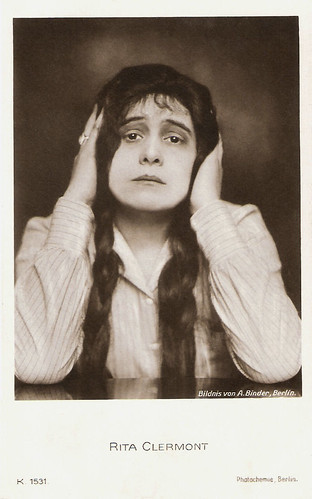
German postcard by Photochemie, Berlin, no. K. 1531. Photo: Alex Binder, Berlin.

German postcard by Photochemie, Berlin, no. K. 1659. Photo: Berliner Illustrations Gesellschaft.
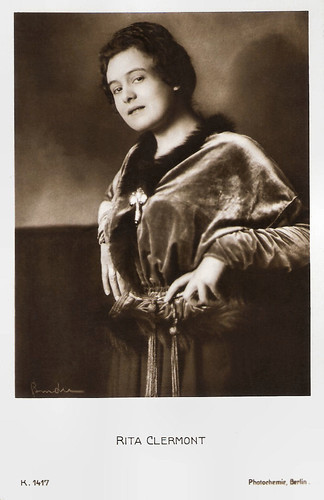
German postcard by Photochemie, Berlin, no. K 1417. Photo: Alex Binder.
Flappers, 'backfisches' and cheerful, rebellious girls
Rita Clermont was born Maria Juliane Forstner in 1894 in Regensburg, German Empire, into a middle-class family.
She became interested in acting at an early age. In 1910 she received acting lessons at the Munich Lustspielhaus from chief director Willy Kissmer, whom she followed in 1911 for her first engagement at the Stadttheater von Landshut. Then she came to the City Theater of Nuremberg and then to the Bremen City Theater. A year later she reached Berlin, where she appeared at the Volksbühne.
In 1915, Oskar Messter discovered her for the film and gave her the leading role in the comedy Fräulein Hochmut/Miss Arrogance (Franz Hofer, 1915). Hofer directed her in a series of similar cheerful stories, in which she mimed flappers, 'backfisches' and cheerful, rebellious girls such as in So'n Rackerchen/Such a rascal (William Karfiol, 1916).
She appeared in the German silent film Das unheimliche Haus/The Uncanny House (Richard Oswald, 1916), a mystery film starring Werner Krauss , Reinhold Schünzel , and Lupu Pick. It was released in three parts. The second part was called Der chinesische Götze/The Chinese idol and the third Freitag, der 13/Friday the 13th.
The following year, she played the female lead in the drama Der Schloßherr von Hohenstein/The Lord of Hohenstein (Richard Oswald, 1917) starring Bernd Aldor , and Lupu Pick. She then appeared in the historical film Nocturno der Liebe/Nocturne of Love (Carl Boese, 1919) that portrays the life of the composer Frederic Chopin ( Conrad Veidt ).
Veidt was also her co-star in the drama Die Prostitution/Prostitution (Richard Oswald, 1919) was released in two parts Das gelbe Haus/The Yellow House and Die sich verkaufen/Those who sell themselves. It was one of several enlightenment films made during the era by Richard Oswald. The physician Magnus Hirschfeld was an advisor on the production.
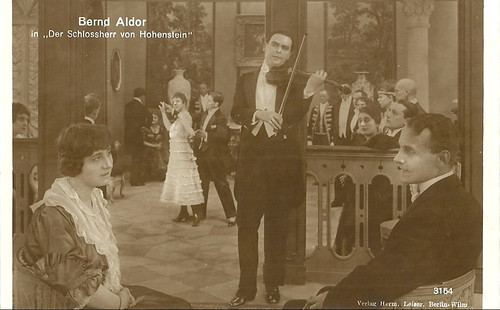
German postcard by Verlag Hermann Leiser, Berlin, no. 3154. Photo: Richard Oswald-Film. Bernd Aldor playing the violin in the German silent film Der Schloßherr von Hohenstein/The manor of Hohenstein (Richard Oswald, 1917). The woman left in the foreground is Rita Clermont.
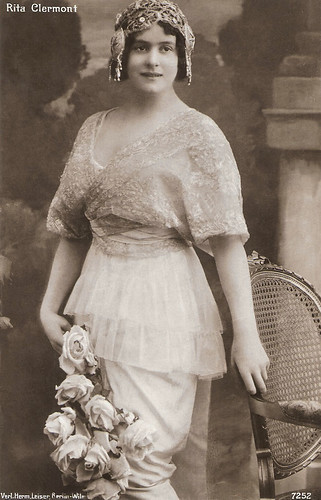
German postcard by Verlag Hermann Leiser, Berlin-Wilm., no. 7252.
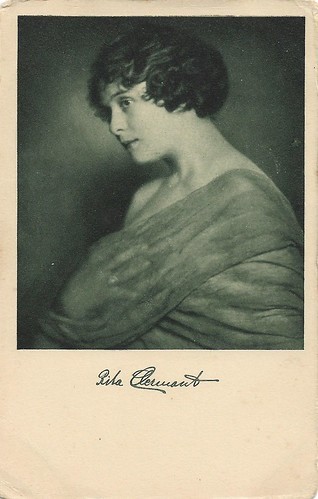
German postcard by Verlag W.J. Mörlins / Ross Verlag, Berlin, no. 9011/1. (With the logo of Rotophot). Photo: Karl Schenker.
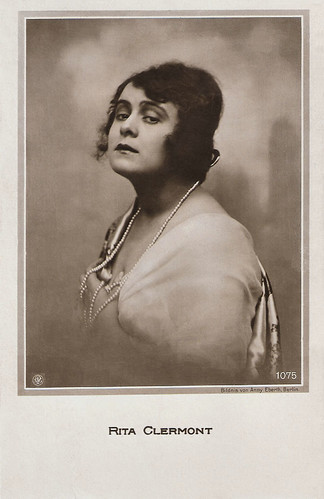
German postcard by NPG, no. 1075. Photo: Anny Eberth, Berlin.
Comedies, melodramas, and also educational films
Rita Clermont acted in very different productions such as comedies, melodramas, and also educational films. When she suffered a serious accident while filming Karl Halden's film Der Shawl der Kaiserin Katherina II/The Shawl of Empress Katherina II (1920), she hit the headlines, but her fame as a screen star began to wane noticeably.
She played in Betrüger des Volkes/Deceiver of the People (Reinhold Schünzel, 1921) starring Charles Willy Kayser . Kayser directed her in Tanz der Leidenschaft/Dance of Passions (Charles Willy Kayser, 1922). She played a supporting part in Irene d'Or/Irene of Gold (Karl Sander, Frederic Zelnik, 1923), starring Margarete Schlegel and Hans Albers .
Finally, she starred in the comedy Maud Rockfellers Wette/Maud Rockefeller's Bet (Erich Eriksen, 1924) with Erich Kaiser-Titz . After 1924 she mended her film career and lived with her husband, factory owner Kurt Hetschingk, whom she had married in 1919.
It was not until the 1940s that she appeared again in front of the camera, reportedly on three experimental programs of the Fernsehsender Paul Nipkow. However, only the participation in the TV film Abenteuer in Petersburg/Adventure in Petersburg (1941) can be proven. Her last screen appearance was in the TV film Grenzgänger/Frontier workers (Ludwig Cremer, 1962).
Rita Clermont passed away in 1969 in Munich, West Germany. She was 75. Her marriage with Kurt Hetschingk was childless.
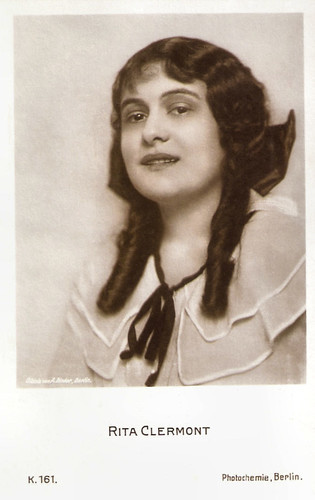
German postcard by Photochemie, Berlin, no. K. 161. Photo: Alex Binder, Berlin.
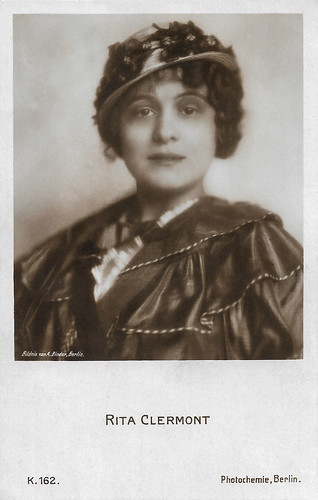
German postcard by Photochemie, Berlin, no. K. 162. Photo: Alex Binder, Berlin.
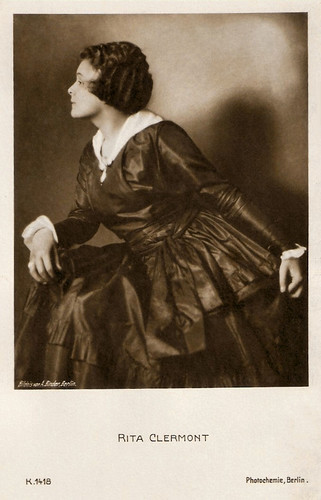
German postcard by Photochemie, Berlin, no. K. 1418. Photo: Alex Binder, Berlin.
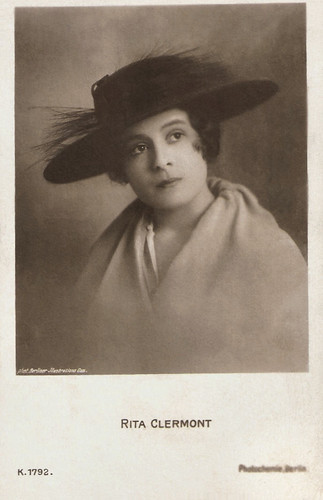
German postcard by Photochemie, Berlin, no. K. 1792. Photo: Berliner Illustrations Gesellschaft.
Sources: Stephanie D'heil (Steffi-Line - German), Wikipedia (German and English), and .

German postcard by Photochemie, Berlin, no. K. 1531. Photo: Alex Binder, Berlin.

German postcard by Photochemie, Berlin, no. K. 1659. Photo: Berliner Illustrations Gesellschaft.

German postcard by Photochemie, Berlin, no. K 1417. Photo: Alex Binder.
Flappers, 'backfisches' and cheerful, rebellious girls
Rita Clermont was born Maria Juliane Forstner in 1894 in Regensburg, German Empire, into a middle-class family.
She became interested in acting at an early age. In 1910 she received acting lessons at the Munich Lustspielhaus from chief director Willy Kissmer, whom she followed in 1911 for her first engagement at the Stadttheater von Landshut. Then she came to the City Theater of Nuremberg and then to the Bremen City Theater. A year later she reached Berlin, where she appeared at the Volksbühne.
In 1915, Oskar Messter discovered her for the film and gave her the leading role in the comedy Fräulein Hochmut/Miss Arrogance (Franz Hofer, 1915). Hofer directed her in a series of similar cheerful stories, in which she mimed flappers, 'backfisches' and cheerful, rebellious girls such as in So'n Rackerchen/Such a rascal (William Karfiol, 1916).
She appeared in the German silent film Das unheimliche Haus/The Uncanny House (Richard Oswald, 1916), a mystery film starring Werner Krauss , Reinhold Schünzel , and Lupu Pick. It was released in three parts. The second part was called Der chinesische Götze/The Chinese idol and the third Freitag, der 13/Friday the 13th.
The following year, she played the female lead in the drama Der Schloßherr von Hohenstein/The Lord of Hohenstein (Richard Oswald, 1917) starring Bernd Aldor , and Lupu Pick. She then appeared in the historical film Nocturno der Liebe/Nocturne of Love (Carl Boese, 1919) that portrays the life of the composer Frederic Chopin ( Conrad Veidt ).
Veidt was also her co-star in the drama Die Prostitution/Prostitution (Richard Oswald, 1919) was released in two parts Das gelbe Haus/The Yellow House and Die sich verkaufen/Those who sell themselves. It was one of several enlightenment films made during the era by Richard Oswald. The physician Magnus Hirschfeld was an advisor on the production.

German postcard by Verlag Hermann Leiser, Berlin, no. 3154. Photo: Richard Oswald-Film. Bernd Aldor playing the violin in the German silent film Der Schloßherr von Hohenstein/The manor of Hohenstein (Richard Oswald, 1917). The woman left in the foreground is Rita Clermont.

German postcard by Verlag Hermann Leiser, Berlin-Wilm., no. 7252.

German postcard by Verlag W.J. Mörlins / Ross Verlag, Berlin, no. 9011/1. (With the logo of Rotophot). Photo: Karl Schenker.

German postcard by NPG, no. 1075. Photo: Anny Eberth, Berlin.
Comedies, melodramas, and also educational films
Rita Clermont acted in very different productions such as comedies, melodramas, and also educational films. When she suffered a serious accident while filming Karl Halden's film Der Shawl der Kaiserin Katherina II/The Shawl of Empress Katherina II (1920), she hit the headlines, but her fame as a screen star began to wane noticeably.
She played in Betrüger des Volkes/Deceiver of the People (Reinhold Schünzel, 1921) starring Charles Willy Kayser . Kayser directed her in Tanz der Leidenschaft/Dance of Passions (Charles Willy Kayser, 1922). She played a supporting part in Irene d'Or/Irene of Gold (Karl Sander, Frederic Zelnik, 1923), starring Margarete Schlegel and Hans Albers .
Finally, she starred in the comedy Maud Rockfellers Wette/Maud Rockefeller's Bet (Erich Eriksen, 1924) with Erich Kaiser-Titz . After 1924 she mended her film career and lived with her husband, factory owner Kurt Hetschingk, whom she had married in 1919.
It was not until the 1940s that she appeared again in front of the camera, reportedly on three experimental programs of the Fernsehsender Paul Nipkow. However, only the participation in the TV film Abenteuer in Petersburg/Adventure in Petersburg (1941) can be proven. Her last screen appearance was in the TV film Grenzgänger/Frontier workers (Ludwig Cremer, 1962).
Rita Clermont passed away in 1969 in Munich, West Germany. She was 75. Her marriage with Kurt Hetschingk was childless.

German postcard by Photochemie, Berlin, no. K. 161. Photo: Alex Binder, Berlin.

German postcard by Photochemie, Berlin, no. K. 162. Photo: Alex Binder, Berlin.

German postcard by Photochemie, Berlin, no. K. 1418. Photo: Alex Binder, Berlin.

German postcard by Photochemie, Berlin, no. K. 1792. Photo: Berliner Illustrations Gesellschaft.
Sources: Stephanie D'heil (Steffi-Line - German), Wikipedia (German and English), and .
Published on August 11, 2021 22:00
August 10, 2021
Poker anyone?
EFSP loves to discover the niches of the film star postcard world. In 2016 we did a post with French playing cards with film stars. The photos were made in colour by the great Sam Lévin, probably around 1960. Recently, we found American Arcade cards designed like playing cards with a cowboy star in the centre. Arcade cards were issued from penny arcade vending machines located on seaside boardwalks of North America. There must have been several series of these playing-cards through the years while the first cards in this post date from 1928 and the last ones date from the 1950s. The first card seems to have a bullet hole. So, in which seaside saloon were these cards used for a tough game of poker?
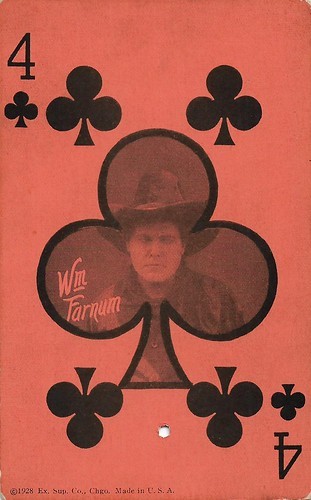
American Arcade playing-card card by Ex.[Exhibit] Sup[ply]. Co., Chicago, USA, 1928.
American actor William Farnum (1876-1953) was one of the first major movie stars. From 1914 to 1925, Farnum was one of the biggest sensations in Hollywood, earning $10,000 a week. Farnum's silent pictures include the Westerns The Spoilers (1914) - which culminates in a spectacular saloon fistfight, Drag Harlan (1920), and the drama-adventure If I Were King (1921).
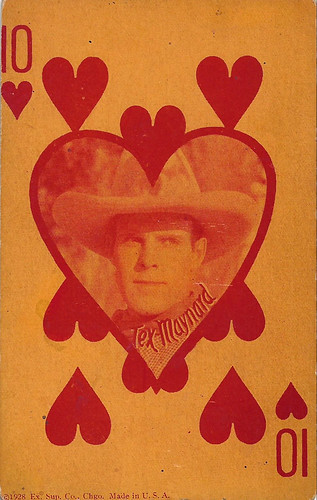
American Arcade playing-card card by Ex.[Exhibit] Sup[ply]. Co., Chicago, USA, 1928.
Kermit Roosevelt 'Tex' Maynard (1897–1971) was an American stuntman, actor, and performer, who often worked as a stand-in for his brother cowboy hero Ken Maynard and other actors. Later he became a star in minor Westerns.

American Arcade playing-card card by Ex.[Exhibit] Sup[ply]. Co., Chicago, USA, 1928.
Antonio 'Tony' Moreno (1887-1967) was a Spanish-born American actor and film director of the silent film era and through the 1950s. In his early films, Moreno was often typecast as the 'Latin Lover' opposite such stars as Pola Negri, Alice Terry, and Greta Garbo. However, throughout his career, he also played cowboys in such Westerns as The Border Legion (1924), Romance of the Rio Grande (1929) and John Ford's classic The Searchers (1956).
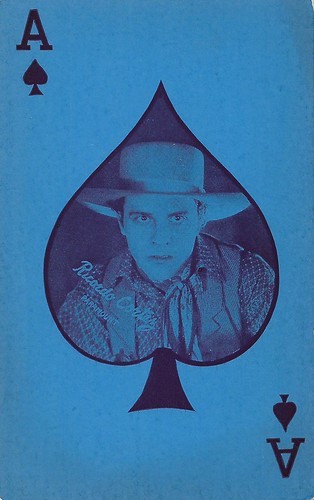
American Arcade playing-card card by Ex.[Exhibit] Sup[ply]. Co., Chicago, USA, 1928. Paramount.
Ricardo Cortez (1900-1977) was an American screen actor and director, who peaked in the 1920s as Paramount's romantic lover opposite the big female stars of the decade. He also starred in Kames Cruze's classic silent Western The Pony Express (1925). In the 1930s he played the first Sam Spade on the screen.
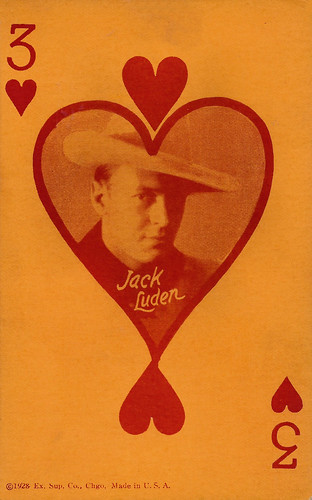
American Arcade card by Ex.[Exhibit] Sup[ply]. Co., Chicago, USA, 1928.
The story of Jack Luden (1902-1951) is one of the saddest in Hollywood. Convicted of heroin possession and passing bad checks, the former cowboy star died in San Quentin State Prison.
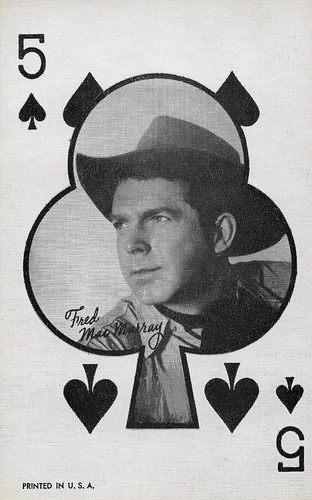
American Arcade playing-card card.
Fred MacMurray (1908-1991) was an American actor and singer who appeared in more than 100 films and a successful television series during a career that spanned nearly a half-century, from 1935 to the 1970s. He often played the quintessential nice guy, but some of his strongest and best-remembered performances cast him against type as a villain such as in director Billy Wilder's Film Noir Double Indemnity (1944). MacMurray also starred in such Westerns as At Gunpoint (1955) and Gun for a Coward (1956).
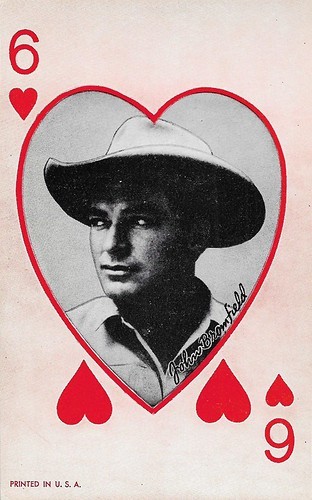
American Arcade playing-card card.
From the 1950s, American film and television actor John Bromfield (1922-2005) became a famous TV western hero. In the middle 1950s, Bromfield appeared in westerns, such as NBC's Frontier anthology series in the role of a sheriff in the episode 'The Hanging at Thunder Butte Creek'. In 1956, Bromfield was cast as law enforcement officer Frank Morgan in the syndicated western-themed crime drama series The Sheriff of Cochise, and in its spin-off, U.S. Marshal. The real sheriff of Cochise County at the time, Jack Howard, visited the set when the program began and made Bromfield an honorary deputy.
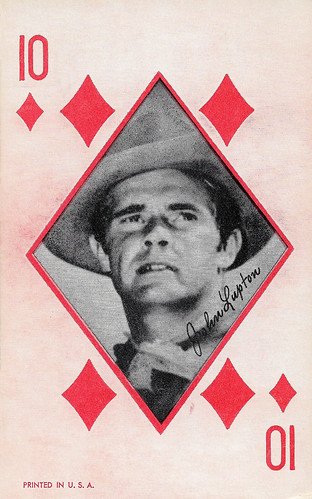
American Arcade card.
John Lupton (1928-1993) was an American film and television actor. Lupton was tall, lanky, and boyishly handsome, very much like James Stewart or Henry Fonda, but he never achieved similar fame A reliable actor, if not particularly distinctive, he enjoyed a four-decade-long career with 260 credits in film productions and on television. His biggest claim to fame was as the co-star of the Western TV series Broken Arrow (1956).
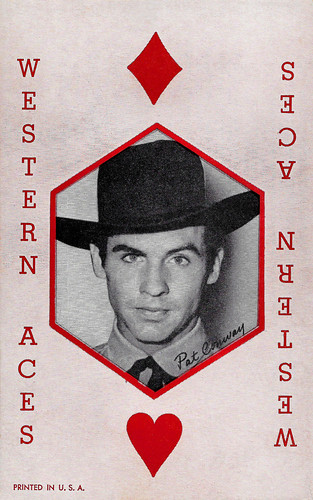
American Arcade card in the Western Aces series. Pat Conway as Clay Collister in Tombstone Territory (1957-1960).
Pat Conway (1931-1981) was an American film and television actor best known for starring as Sheriff Clay Hollister on the Western television series Tombstone Territory (1957-1960). He was the grandson of silent screen actor Francis X. Bushman and the son of director Jack Conway.
The Arcade cards were manufactured by the Exhibit Supply Company of Chicago, which began issuing the cards in 1921 and continued to release new cards until 1966. Check out our first post on Arcade cards and a special one on the Arcade cowboys.

American Arcade playing-card card by Ex.[Exhibit] Sup[ply]. Co., Chicago, USA, 1928.
American actor William Farnum (1876-1953) was one of the first major movie stars. From 1914 to 1925, Farnum was one of the biggest sensations in Hollywood, earning $10,000 a week. Farnum's silent pictures include the Westerns The Spoilers (1914) - which culminates in a spectacular saloon fistfight, Drag Harlan (1920), and the drama-adventure If I Were King (1921).

American Arcade playing-card card by Ex.[Exhibit] Sup[ply]. Co., Chicago, USA, 1928.
Kermit Roosevelt 'Tex' Maynard (1897–1971) was an American stuntman, actor, and performer, who often worked as a stand-in for his brother cowboy hero Ken Maynard and other actors. Later he became a star in minor Westerns.

American Arcade playing-card card by Ex.[Exhibit] Sup[ply]. Co., Chicago, USA, 1928.
Antonio 'Tony' Moreno (1887-1967) was a Spanish-born American actor and film director of the silent film era and through the 1950s. In his early films, Moreno was often typecast as the 'Latin Lover' opposite such stars as Pola Negri, Alice Terry, and Greta Garbo. However, throughout his career, he also played cowboys in such Westerns as The Border Legion (1924), Romance of the Rio Grande (1929) and John Ford's classic The Searchers (1956).

American Arcade playing-card card by Ex.[Exhibit] Sup[ply]. Co., Chicago, USA, 1928. Paramount.
Ricardo Cortez (1900-1977) was an American screen actor and director, who peaked in the 1920s as Paramount's romantic lover opposite the big female stars of the decade. He also starred in Kames Cruze's classic silent Western The Pony Express (1925). In the 1930s he played the first Sam Spade on the screen.

American Arcade card by Ex.[Exhibit] Sup[ply]. Co., Chicago, USA, 1928.
The story of Jack Luden (1902-1951) is one of the saddest in Hollywood. Convicted of heroin possession and passing bad checks, the former cowboy star died in San Quentin State Prison.

American Arcade playing-card card.
Fred MacMurray (1908-1991) was an American actor and singer who appeared in more than 100 films and a successful television series during a career that spanned nearly a half-century, from 1935 to the 1970s. He often played the quintessential nice guy, but some of his strongest and best-remembered performances cast him against type as a villain such as in director Billy Wilder's Film Noir Double Indemnity (1944). MacMurray also starred in such Westerns as At Gunpoint (1955) and Gun for a Coward (1956).

American Arcade playing-card card.
From the 1950s, American film and television actor John Bromfield (1922-2005) became a famous TV western hero. In the middle 1950s, Bromfield appeared in westerns, such as NBC's Frontier anthology series in the role of a sheriff in the episode 'The Hanging at Thunder Butte Creek'. In 1956, Bromfield was cast as law enforcement officer Frank Morgan in the syndicated western-themed crime drama series The Sheriff of Cochise, and in its spin-off, U.S. Marshal. The real sheriff of Cochise County at the time, Jack Howard, visited the set when the program began and made Bromfield an honorary deputy.

American Arcade card.
John Lupton (1928-1993) was an American film and television actor. Lupton was tall, lanky, and boyishly handsome, very much like James Stewart or Henry Fonda, but he never achieved similar fame A reliable actor, if not particularly distinctive, he enjoyed a four-decade-long career with 260 credits in film productions and on television. His biggest claim to fame was as the co-star of the Western TV series Broken Arrow (1956).

American Arcade card in the Western Aces series. Pat Conway as Clay Collister in Tombstone Territory (1957-1960).
Pat Conway (1931-1981) was an American film and television actor best known for starring as Sheriff Clay Hollister on the Western television series Tombstone Territory (1957-1960). He was the grandson of silent screen actor Francis X. Bushman and the son of director Jack Conway.
The Arcade cards were manufactured by the Exhibit Supply Company of Chicago, which began issuing the cards in 1921 and continued to release new cards until 1966. Check out our first post on Arcade cards and a special one on the Arcade cowboys.
Published on August 10, 2021 22:00
August 9, 2021
Jane Withers (1926-2021)
Last Saturday, 7 August 2021, American actress, model, and singer Jane Withers (1926) passed away. She is known for being one of the most popular child film stars of the 1930s and early 1940s. She played a freckled, dark-haired hellraiser in several B-films. Jane Withers was 95.
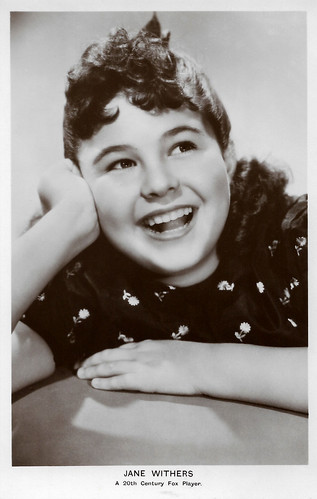
British postcard in the Picturegoer Series, no. 1000a. Photo: 20th Century Fox.
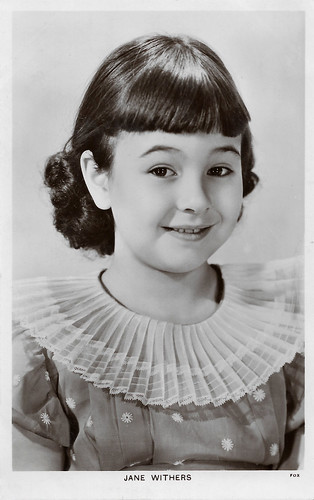
British postcard in the Picturegoer Series, London, no. 1000. Photo: 20th Century Fox.
A name to fit a marquee
Jane Withers was born in Atlanta, Georgia, in 1926. Her parents were Ruth and Walter Withers, who taught Bible classes at the local Presbyterian church. Her mother gave her the name Jane so it would fit on a marquee.
She began her career as a child actress at the age of three in Atlanta as Dixie's Dainty Dewdrop on the radio show 'Aunt Sally's Kiddie Club'. A spot-on mimic, she was simply uncanny when it came to impersonating such superstars of her day as W.C. Fields, Marie Dressler, and Charles Chaplin .
In the early 1930s, Withers and her mother moved to Hollywood, where she worked as a child model and a bit-part player in several films in 1932 and 1933. Jane was enrolled in Lawlor's Professional School.
Her big break came when she landed a supporting role in the Shirley Temple film Bright Eyes (David Butler, 1934). Her character, Joy Smythe, was spoiled and obnoxious, a perfect foil to Temple's sweet personality.
Her first major success came in the form of the title role in Ginger (Lewis Seiler, 1935), in which Jane imitated the balcony scene from 'Romeo and Juliet' and was rewarded by the studio with a contract of $125 weekly for six months.
Through the remainder of the 1930s, Withers starred in several films every year, including Paddy O'Day (Lewis Seiler, 1936) with the young Rita Hayworth , The Farmer Takes a Wife (Victor Fleming, 1935), and Little Miss Nobody (John G. Blystone, 1936).
Gary Brumburgh at IMDb : "Where Shirley was cuddly and ultra huggable, brunette-banged Jane was fun, rambunctious and full of kinetic energy--a scrappy little tomboy who could take on any boy at any time. Her lively vehicles took full advantage of her talents for impersonating movie stars, too." Filmgoers flocked to see her films, and Withers became one of the top 10 box-office stars in 1937 and 1938.
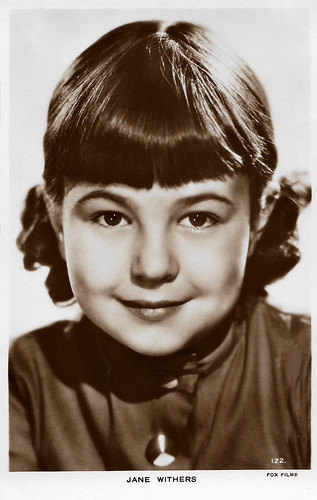
British Real Photograph postcard, no. 122. Photo: Fox Films.
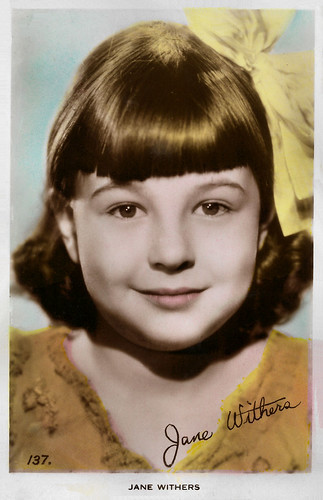
British Art Photo postcard, no. 137.
Josephine the plumber pushing comet cleanser
Jane Withers received her first screen kiss at age 13 in Boy Friend (James Tinling, 1939). Her popularity was such that Fox gave her 'name' co-stars: The Ritz Brothers in Pack Up Your Troubles (H. Bruce Humberstone, 1939) and Gene Autry in Shooting High (Alfred E. Green, 1940).
However, Jane's antics simply didn't play as well and the studio began to lose interest. Darryl F. Zanuck let her go in 1942. Jane signed a three-year picture deal with Republic Pictures with lukewarm results.
Her best dramatic role at that time came with The North Star (Lewis Milestone, 1943), starring Anne Baxter. In 1947, the same year as her last picture of the decade, Jane married a wealthy Texas oilman, William Moss, and had three children by him - William, Wendy, and Randy. The marriage was not a happy one and lasted only six years.
She also was suffering from rheumatoid arthritis. In 1955, she remarried, this time to Kenneth Errair, one-quarter of the harmonizing group The Four Freshmen. They had two children, Ken and Kendall Jane.
At the same time, she attempted a Hollywood comeback. While studying directing at the USC film school, she met producer/director George Stevens who cast her in an enviable character role in the epic-sized Giant (1956) supporting Rock Hudson , Elizabeth Taylor , and James Dean . Other film roles followed with The Right Approach (David Butler, 1961) and Captain Newman, M.D. (David Miller, 1963).
Gary Brumburgh: "It was TV, however, that would turn Jane into a wealthy woman as a friendly household pitchwoman. Her decades-long job as the dress-downed Josephine the Plumber pushing Comet cleanser made her one popular gal when working in films became a non-issue."
She appeared in TV advertisements for more than a decade beginning in the mid-1960s. From time to time she would make guest appearances on such fun, lightweight shows as The Munsters (1964-1966), The Love Boat (1980), Hart to Hart (1979), and Murder, She Wrote (1984-1993).
She wrote the original story filmed as Small Town Deb (Harold D. Schuster, 1942), using the pseudonym Jerrie Walters. In 1979, she was honored by the Young Artist Foundation with its very first Former Child Star 'Lifetime Achievement' Award recognizing her outstanding achievements within the film industry as a child actress.
She took over the role of gargoyle Laverne in Disney's animation film The Hunchback of Notre Dame (Gary Trousdale, Kirk Wise, 1996) following the death of Mary Wickes and had to match Wickes' voice and performance so that audiences wouldn't be able to detect the difference. She repeated the role in the sequel, The Hunchback of Notre Dame II (Bradley Raymond, 2002).
Jane Withers became a widow in 1968 when her second husband, Ken Errair, perished in a plane crash. She also lost one of her five children, Randy, to cancer when he was only 33. Jane Withers died in Burbank, Califonia, of natural causes, in 2021.
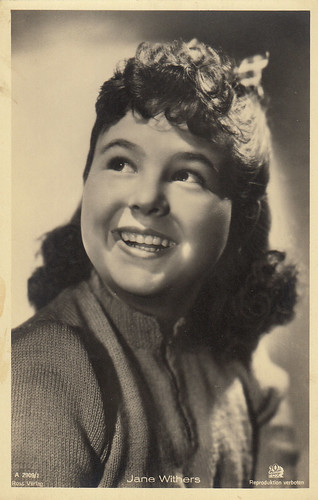
German postcard by Ross Verlag, no. A 2909/1, 1939-1940. Photo: 20th Century Fox. Collection: Marlene Pilaete.
Jane Withers in a scene from Little Miss Nobody (John G. Blystone, 1936). Source: friendsfamilyaccount (YouTube).
Sources: (IMDb), Wikipedia, and .

British postcard in the Picturegoer Series, no. 1000a. Photo: 20th Century Fox.

British postcard in the Picturegoer Series, London, no. 1000. Photo: 20th Century Fox.
A name to fit a marquee
Jane Withers was born in Atlanta, Georgia, in 1926. Her parents were Ruth and Walter Withers, who taught Bible classes at the local Presbyterian church. Her mother gave her the name Jane so it would fit on a marquee.
She began her career as a child actress at the age of three in Atlanta as Dixie's Dainty Dewdrop on the radio show 'Aunt Sally's Kiddie Club'. A spot-on mimic, she was simply uncanny when it came to impersonating such superstars of her day as W.C. Fields, Marie Dressler, and Charles Chaplin .
In the early 1930s, Withers and her mother moved to Hollywood, where she worked as a child model and a bit-part player in several films in 1932 and 1933. Jane was enrolled in Lawlor's Professional School.
Her big break came when she landed a supporting role in the Shirley Temple film Bright Eyes (David Butler, 1934). Her character, Joy Smythe, was spoiled and obnoxious, a perfect foil to Temple's sweet personality.
Her first major success came in the form of the title role in Ginger (Lewis Seiler, 1935), in which Jane imitated the balcony scene from 'Romeo and Juliet' and was rewarded by the studio with a contract of $125 weekly for six months.
Through the remainder of the 1930s, Withers starred in several films every year, including Paddy O'Day (Lewis Seiler, 1936) with the young Rita Hayworth , The Farmer Takes a Wife (Victor Fleming, 1935), and Little Miss Nobody (John G. Blystone, 1936).
Gary Brumburgh at IMDb : "Where Shirley was cuddly and ultra huggable, brunette-banged Jane was fun, rambunctious and full of kinetic energy--a scrappy little tomboy who could take on any boy at any time. Her lively vehicles took full advantage of her talents for impersonating movie stars, too." Filmgoers flocked to see her films, and Withers became one of the top 10 box-office stars in 1937 and 1938.

British Real Photograph postcard, no. 122. Photo: Fox Films.

British Art Photo postcard, no. 137.
Josephine the plumber pushing comet cleanser
Jane Withers received her first screen kiss at age 13 in Boy Friend (James Tinling, 1939). Her popularity was such that Fox gave her 'name' co-stars: The Ritz Brothers in Pack Up Your Troubles (H. Bruce Humberstone, 1939) and Gene Autry in Shooting High (Alfred E. Green, 1940).
However, Jane's antics simply didn't play as well and the studio began to lose interest. Darryl F. Zanuck let her go in 1942. Jane signed a three-year picture deal with Republic Pictures with lukewarm results.
Her best dramatic role at that time came with The North Star (Lewis Milestone, 1943), starring Anne Baxter. In 1947, the same year as her last picture of the decade, Jane married a wealthy Texas oilman, William Moss, and had three children by him - William, Wendy, and Randy. The marriage was not a happy one and lasted only six years.
She also was suffering from rheumatoid arthritis. In 1955, she remarried, this time to Kenneth Errair, one-quarter of the harmonizing group The Four Freshmen. They had two children, Ken and Kendall Jane.
At the same time, she attempted a Hollywood comeback. While studying directing at the USC film school, she met producer/director George Stevens who cast her in an enviable character role in the epic-sized Giant (1956) supporting Rock Hudson , Elizabeth Taylor , and James Dean . Other film roles followed with The Right Approach (David Butler, 1961) and Captain Newman, M.D. (David Miller, 1963).
Gary Brumburgh: "It was TV, however, that would turn Jane into a wealthy woman as a friendly household pitchwoman. Her decades-long job as the dress-downed Josephine the Plumber pushing Comet cleanser made her one popular gal when working in films became a non-issue."
She appeared in TV advertisements for more than a decade beginning in the mid-1960s. From time to time she would make guest appearances on such fun, lightweight shows as The Munsters (1964-1966), The Love Boat (1980), Hart to Hart (1979), and Murder, She Wrote (1984-1993).
She wrote the original story filmed as Small Town Deb (Harold D. Schuster, 1942), using the pseudonym Jerrie Walters. In 1979, she was honored by the Young Artist Foundation with its very first Former Child Star 'Lifetime Achievement' Award recognizing her outstanding achievements within the film industry as a child actress.
She took over the role of gargoyle Laverne in Disney's animation film The Hunchback of Notre Dame (Gary Trousdale, Kirk Wise, 1996) following the death of Mary Wickes and had to match Wickes' voice and performance so that audiences wouldn't be able to detect the difference. She repeated the role in the sequel, The Hunchback of Notre Dame II (Bradley Raymond, 2002).
Jane Withers became a widow in 1968 when her second husband, Ken Errair, perished in a plane crash. She also lost one of her five children, Randy, to cancer when he was only 33. Jane Withers died in Burbank, Califonia, of natural causes, in 2021.

German postcard by Ross Verlag, no. A 2909/1, 1939-1940. Photo: 20th Century Fox. Collection: Marlene Pilaete.
Jane Withers in a scene from Little Miss Nobody (John G. Blystone, 1936). Source: friendsfamilyaccount (YouTube).
Sources: (IMDb), Wikipedia, and .
Published on August 09, 2021 22:00
August 8, 2021
Françoise Arnoul (1931-2021)
During our trip to Italy, the French actress Françoise Arnoul passed away after a long illness in Paris on 20 July 2021. In the early 1950s, the cute and pretty actress was presented as the new French sex symbol. Soon she was overshadowed by the spectacular Brigitte Bardot, but Arnoul had enough talent and range to forge a decent film career for herself. Françoise Arnoul was 90.
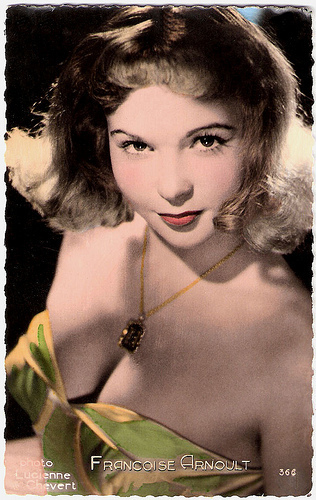
French postcard by Editions P.I., Paris, no. 366. Photo: Lucienne Chevert.
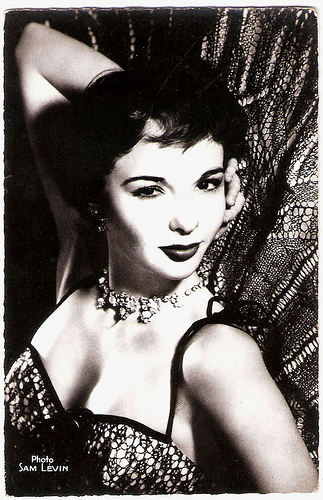
French postcard by Edition du Globe, Paris, no. 429. Photo: Sam Lévin.
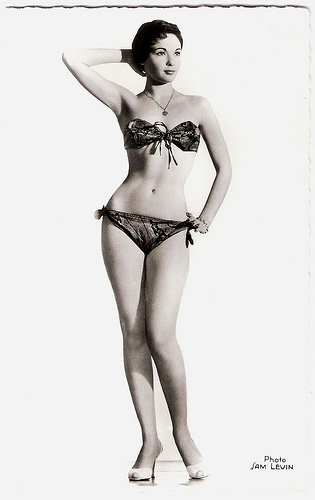
French postcard by Editions du Globe, no. 617. Photo: Sam Lévin, Paris.
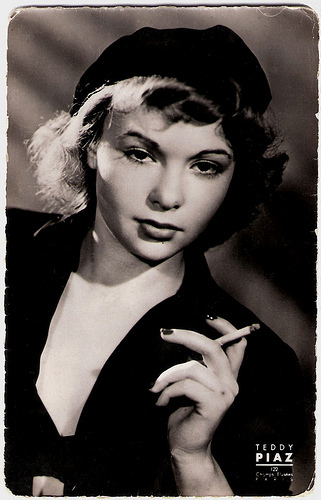
French postcard by Editions du Globe, Paris, no. 113. Photo: Teddy Piaz, Paris.
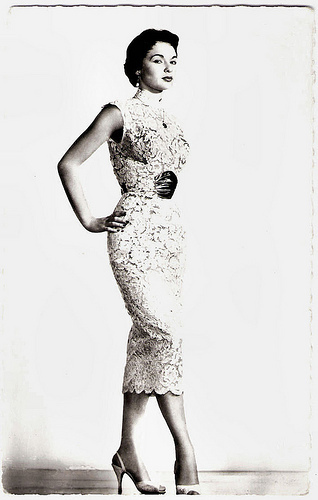
French postcard by Edition du Globe, Paris, no. 355.
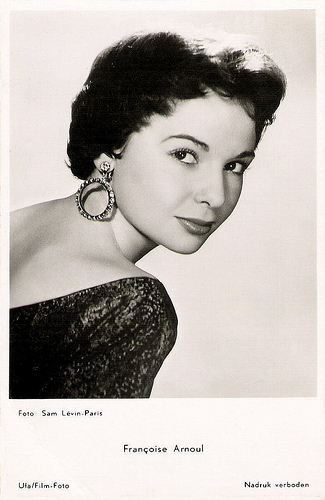
Dutch postcard by Gebr. Spanjersberg N.V., Rotterdam (Dutch licency holder of Ufa (Universum-Film Aktiengesellschaft, Berlin-Tempelhof), no. 1110. Photo: Sam Lévin, Paris.
Undressed scenes
Françoise Arnoul was born as Françoise Annette Marie Mathilde Gautsch in Constantine, France (now Algeria), in 1931. Her father was a general in the army, Charles Gautsch; her mother was a former stage actress, Jeanne Gradwohl, who worked before her marriage under the name of Jeanne Henry.
Françoise grew up in Rabat and Casablanca, and after WWII she returned to Paris. Her mother proved to be valuable support when her daughter expressed a desire to take courses in drama. She attended the drama classes of Andree Bauer-Thérond, and made her film debut as an extra in Rendez-vous de juillet/Rendezvous in July (Jacques Becker, 1949).
Her first bigger role was in L'Épave/Sin and Desire (Willy Rozier, 1949) in which she had some undressed scenes. It made her a star overnight. She was touted as the newest French sex symbol in films like Nous irons à Paris/We Will All Go to Paris (Jean Boyer, 1950) opposite nice and attractive Philippe Lemaire .
In the morally rigid 1950s, she played sexy and sensuous characters, that were also often troubled and destructive. She was the perverse femme fatale in films like the Georges Siménon adaptation Le Fruit défendu/Forbidden Fruit (Henri Verneuil, 1952) in which she seduces a country doctor played by Fernandel and La Rage au corps/Tempest in the Flesh (Ralph Habib, 1953) in which she is the unfaithful wife of Raymond Pellegrin .
Wildly successful was the Film Noir La Chatte/The Cat (Henri Decoin, 1958) in which she played a black leather-clad resistance fighter during World War II. Arnoul made of her questioning scene by the Nazis an erotic extravaganza as she slowly removes her stockings under the officer's lecherous eyes.
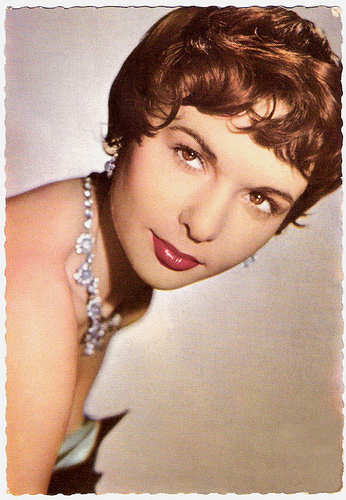
German postcard by Ufa, Berlin-Tempelhof, no. CK-1. Photo: Unifrance Film.
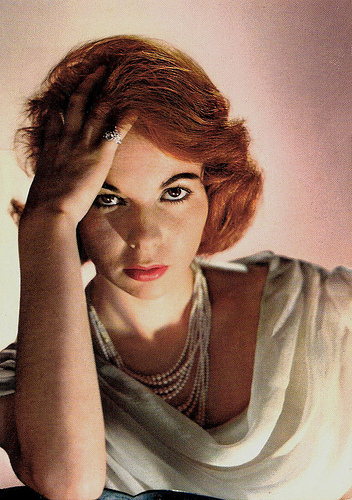
French postcard by Editions P.I.. Paris, no. 1055. Photo: Sam Lévin.
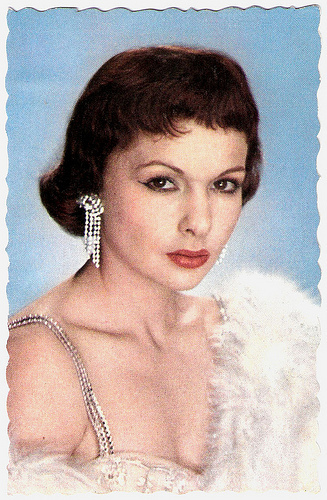
French postcard by Imp. De Marchi Frères, Marseille.
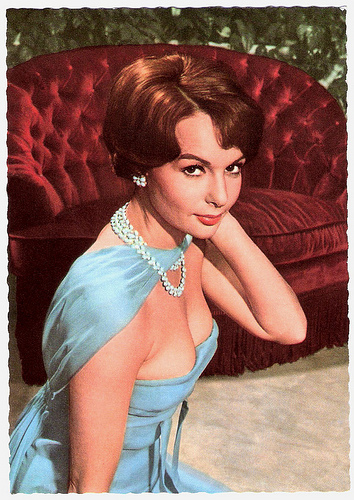
German postcard by Ufa, Berlin-Tempelhof, no. CK-288. Photo: Klaus Collignon / Ufa.
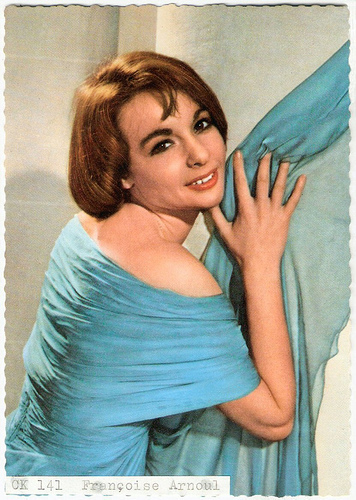
German postcard by Universum-Film Aktiengesellschaft (Ufa), Berlin-Tempelhof, no. CK 141. Photo: Klaus Collignon / Ufa.
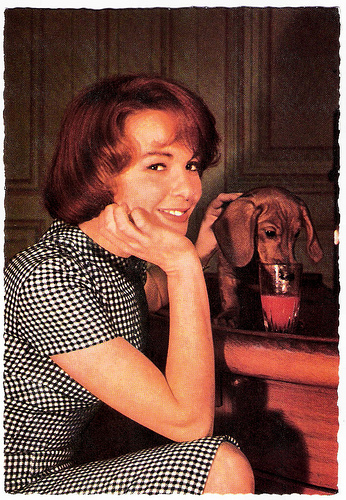
German postcard by WS-Druck, Wanne-Eickel, no. F 105. Photo: Ringpress / Union / Vogelmann.
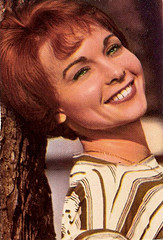
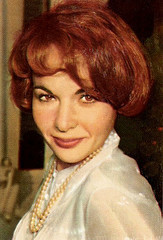
Belgian collector's card, no. 9; Collector's card, no. 98.
An animal endowed with happiness
The unusually pretty and petite Françoise Arnoul proved her talent and range in such highly regarded films as Michelangelo Antonioni’s episode film I Vinti/The Vanquished (1953), the wonderful Fernandel comedy Le Mouton à cinq pattes/The Sheep Has Five Legs (Henri Verneuil, 1954), and Jean Cocteau's Le Testament d'Orphee/The Testament of Orpheus (1960).
In Jean Renoir 's classic French Cancan/French Can-Can (1955), she played Nini, a young laundress from Montmartre, who conquers the Moulin Rouge with her sexy dance.
In 1964, during the shooting of Compartiment tueurs/The Sleeping Car Murder (Costa-Gavras, 1965), she met director Bernard Paul who would become her life partner. From 1956 till 1960, she had been married to publicity agent Georges Cravenne, the future father of the César and Mollière awards.
In the following years, she focussed on assisting Paul with his first films. Together with Marina Vlady , they founded in 1968 the production company Francina, which would produce films like Dernière sortie avant Roissy/Last Exit Before Roissy (Bernard Paul, 1977). Paul died in 1980. His loss affected Francoise dearly and she had difficulty regaining a foothold in the cinema.
During the 1970s her film career had tapered off, but she appeared in Raul Ruiz’ Diálogos de exiliados/Dialogues of the Exiled (1975) and Violette & François (Jacques Rouffio, 1977) as the mother of Violette ( Isabelle Adjani ). She also had some success as a television actress.
In the late 1990s, Françoise Arnoul returned on the screen in character roles in such films as Temps de Chien/Dog Days (Jean Marboeuf, 1996), Post coitum animal triste/Smell of Geraniums (Brigitte Roüan, 1997) and Merci pour le geste/Thanks for the Gesture (Claude Faraldo, 2000). She published her autobiography entitled 'Animal doué de Bonheur' (Animal endowed with happiness) in 1995. In 1997, she was the president of the jury of the Caméra d'Or at the Cannes Film festival.
Françoise Arnoul lived in Paris and remained active as a TV actress. In his bio at Les Gens de Cinéma , Yvan Foucart wrote: "The young vamp has given way to a blooming woman whose wonderful face radiates serenity. She kept her beautiful smile, her eyes still have the same sparkle and she kept an admirably slim silhouette. (...) So, dear Francoise, you understand why we can not forget you. And why we are still in love with you."
Her final film was Le Cancre (2016), directed and written by Paul Vecchiali. At the age of 90, Françoise Arnoul passed away after a long illness in Paris on 20 July 2021.
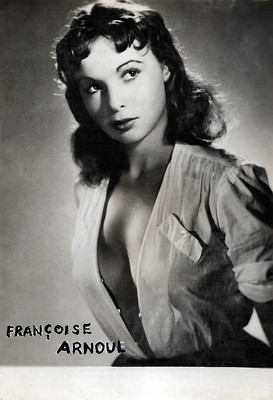
Vintage card.
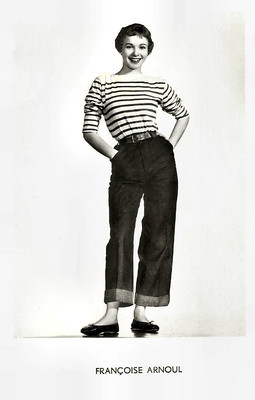
Vintage postcard. Photo: Sam Lévin.
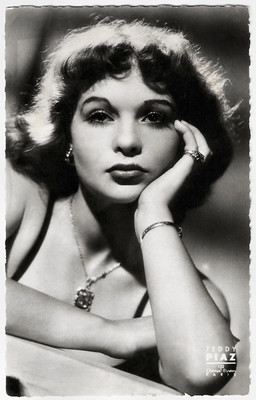
French postcard by Editions du Globe, Paris, no. 122. Photo: Teddy Piaz, Paris.
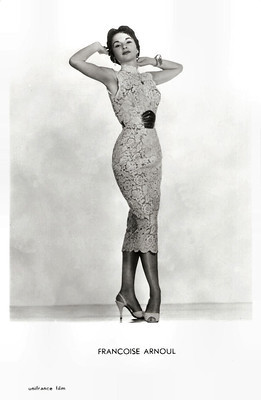
Vintage postcard. Photo: Sam Lévin / Unifrance.
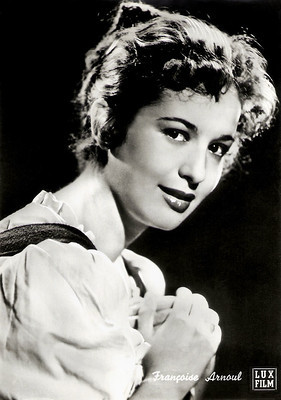
Italian postcard by Bromofoto, Mialano, no. 422. Photo: Lux Film. Françoise Arnoul in Les amants de Tolède/Lovers of Toledo (Henri Decoin, Fernando Palacios, 1953).
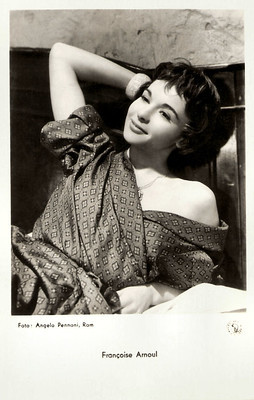
French postcard by Editions P.I., Paris, no. FK 1213. (P.I. was French licence holder for Ufa, Berlin-Tempelhof.) Photo: Angelo Pennoni, Rome / Pallas Filmverleih. Françoise Arnoul in Delirio/Storm (Pierre Billon, Giorgio Capitani, 1954).
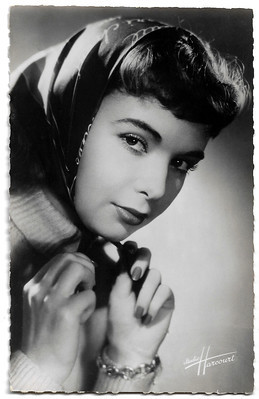
French postcard by Editions du Globe, Paris, no. 236. Photo: Studio Harcourt.
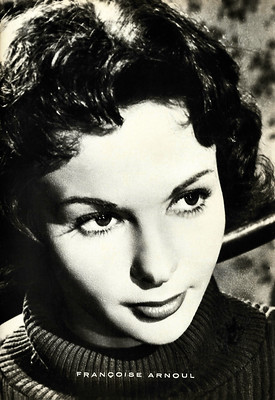
Bulgarian postcard by Bulgarska Fotografia, Sofia.
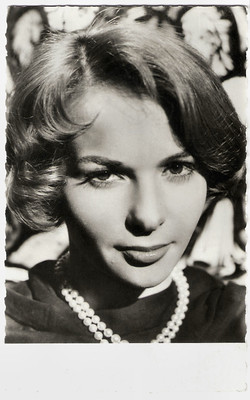
French postcard by Editions P.I., Paris, offered by Les Carbones Korès "Carboplane", no. 796.
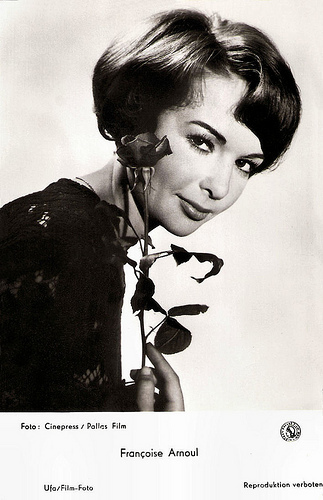
German postcard by Ufa, Berlin. Retail price: 25 Pfg. Photo: Cinepress / Pallas Film.
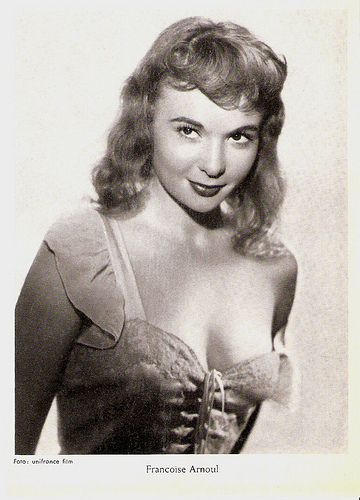
German postcard. Photo: Unifrance film.
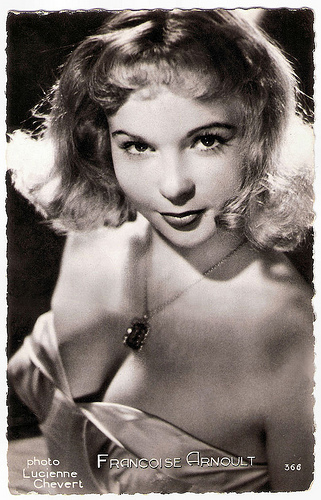
French postcard by Editions P.I., Paris, no. 366. Photo: Lucienne Chevert.
Sources: Yvan Foucart (Les Gens de Cinéma - French), Sandra Brennan (AllMovie), AlloCiné (French), Wikipedia, and .

French postcard by Editions P.I., Paris, no. 366. Photo: Lucienne Chevert.

French postcard by Edition du Globe, Paris, no. 429. Photo: Sam Lévin.

French postcard by Editions du Globe, no. 617. Photo: Sam Lévin, Paris.

French postcard by Editions du Globe, Paris, no. 113. Photo: Teddy Piaz, Paris.

French postcard by Edition du Globe, Paris, no. 355.

Dutch postcard by Gebr. Spanjersberg N.V., Rotterdam (Dutch licency holder of Ufa (Universum-Film Aktiengesellschaft, Berlin-Tempelhof), no. 1110. Photo: Sam Lévin, Paris.
Undressed scenes
Françoise Arnoul was born as Françoise Annette Marie Mathilde Gautsch in Constantine, France (now Algeria), in 1931. Her father was a general in the army, Charles Gautsch; her mother was a former stage actress, Jeanne Gradwohl, who worked before her marriage under the name of Jeanne Henry.
Françoise grew up in Rabat and Casablanca, and after WWII she returned to Paris. Her mother proved to be valuable support when her daughter expressed a desire to take courses in drama. She attended the drama classes of Andree Bauer-Thérond, and made her film debut as an extra in Rendez-vous de juillet/Rendezvous in July (Jacques Becker, 1949).
Her first bigger role was in L'Épave/Sin and Desire (Willy Rozier, 1949) in which she had some undressed scenes. It made her a star overnight. She was touted as the newest French sex symbol in films like Nous irons à Paris/We Will All Go to Paris (Jean Boyer, 1950) opposite nice and attractive Philippe Lemaire .
In the morally rigid 1950s, she played sexy and sensuous characters, that were also often troubled and destructive. She was the perverse femme fatale in films like the Georges Siménon adaptation Le Fruit défendu/Forbidden Fruit (Henri Verneuil, 1952) in which she seduces a country doctor played by Fernandel and La Rage au corps/Tempest in the Flesh (Ralph Habib, 1953) in which she is the unfaithful wife of Raymond Pellegrin .
Wildly successful was the Film Noir La Chatte/The Cat (Henri Decoin, 1958) in which she played a black leather-clad resistance fighter during World War II. Arnoul made of her questioning scene by the Nazis an erotic extravaganza as she slowly removes her stockings under the officer's lecherous eyes.

German postcard by Ufa, Berlin-Tempelhof, no. CK-1. Photo: Unifrance Film.

French postcard by Editions P.I.. Paris, no. 1055. Photo: Sam Lévin.

French postcard by Imp. De Marchi Frères, Marseille.

German postcard by Ufa, Berlin-Tempelhof, no. CK-288. Photo: Klaus Collignon / Ufa.

German postcard by Universum-Film Aktiengesellschaft (Ufa), Berlin-Tempelhof, no. CK 141. Photo: Klaus Collignon / Ufa.

German postcard by WS-Druck, Wanne-Eickel, no. F 105. Photo: Ringpress / Union / Vogelmann.


Belgian collector's card, no. 9; Collector's card, no. 98.
An animal endowed with happiness
The unusually pretty and petite Françoise Arnoul proved her talent and range in such highly regarded films as Michelangelo Antonioni’s episode film I Vinti/The Vanquished (1953), the wonderful Fernandel comedy Le Mouton à cinq pattes/The Sheep Has Five Legs (Henri Verneuil, 1954), and Jean Cocteau's Le Testament d'Orphee/The Testament of Orpheus (1960).
In Jean Renoir 's classic French Cancan/French Can-Can (1955), she played Nini, a young laundress from Montmartre, who conquers the Moulin Rouge with her sexy dance.
In 1964, during the shooting of Compartiment tueurs/The Sleeping Car Murder (Costa-Gavras, 1965), she met director Bernard Paul who would become her life partner. From 1956 till 1960, she had been married to publicity agent Georges Cravenne, the future father of the César and Mollière awards.
In the following years, she focussed on assisting Paul with his first films. Together with Marina Vlady , they founded in 1968 the production company Francina, which would produce films like Dernière sortie avant Roissy/Last Exit Before Roissy (Bernard Paul, 1977). Paul died in 1980. His loss affected Francoise dearly and she had difficulty regaining a foothold in the cinema.
During the 1970s her film career had tapered off, but she appeared in Raul Ruiz’ Diálogos de exiliados/Dialogues of the Exiled (1975) and Violette & François (Jacques Rouffio, 1977) as the mother of Violette ( Isabelle Adjani ). She also had some success as a television actress.
In the late 1990s, Françoise Arnoul returned on the screen in character roles in such films as Temps de Chien/Dog Days (Jean Marboeuf, 1996), Post coitum animal triste/Smell of Geraniums (Brigitte Roüan, 1997) and Merci pour le geste/Thanks for the Gesture (Claude Faraldo, 2000). She published her autobiography entitled 'Animal doué de Bonheur' (Animal endowed with happiness) in 1995. In 1997, she was the president of the jury of the Caméra d'Or at the Cannes Film festival.
Françoise Arnoul lived in Paris and remained active as a TV actress. In his bio at Les Gens de Cinéma , Yvan Foucart wrote: "The young vamp has given way to a blooming woman whose wonderful face radiates serenity. She kept her beautiful smile, her eyes still have the same sparkle and she kept an admirably slim silhouette. (...) So, dear Francoise, you understand why we can not forget you. And why we are still in love with you."
Her final film was Le Cancre (2016), directed and written by Paul Vecchiali. At the age of 90, Françoise Arnoul passed away after a long illness in Paris on 20 July 2021.

Vintage card.

Vintage postcard. Photo: Sam Lévin.

French postcard by Editions du Globe, Paris, no. 122. Photo: Teddy Piaz, Paris.

Vintage postcard. Photo: Sam Lévin / Unifrance.

Italian postcard by Bromofoto, Mialano, no. 422. Photo: Lux Film. Françoise Arnoul in Les amants de Tolède/Lovers of Toledo (Henri Decoin, Fernando Palacios, 1953).

French postcard by Editions P.I., Paris, no. FK 1213. (P.I. was French licence holder for Ufa, Berlin-Tempelhof.) Photo: Angelo Pennoni, Rome / Pallas Filmverleih. Françoise Arnoul in Delirio/Storm (Pierre Billon, Giorgio Capitani, 1954).

French postcard by Editions du Globe, Paris, no. 236. Photo: Studio Harcourt.

Bulgarian postcard by Bulgarska Fotografia, Sofia.

French postcard by Editions P.I., Paris, offered by Les Carbones Korès "Carboplane", no. 796.

German postcard by Ufa, Berlin. Retail price: 25 Pfg. Photo: Cinepress / Pallas Film.

German postcard. Photo: Unifrance film.

French postcard by Editions P.I., Paris, no. 366. Photo: Lucienne Chevert.
Sources: Yvan Foucart (Les Gens de Cinéma - French), Sandra Brennan (AllMovie), AlloCiné (French), Wikipedia, and .
Published on August 08, 2021 22:00
Paul van Yperen's Blog
- Paul van Yperen's profile
- 13 followers
Paul van Yperen isn't a Goodreads Author
(yet),
but they
do have a blog,
so here are some recent posts imported from
their feed.



